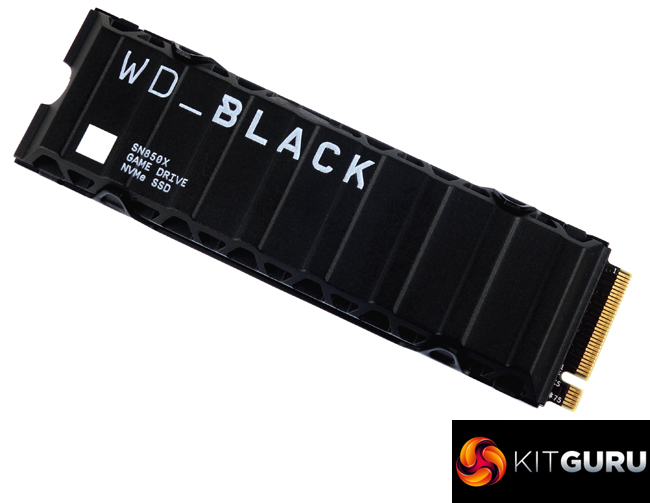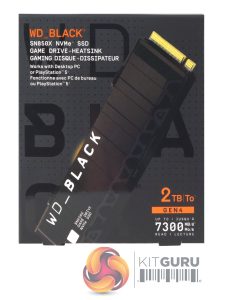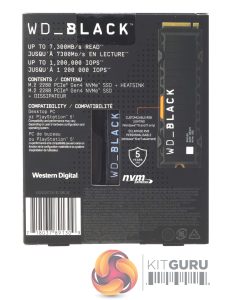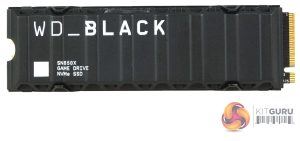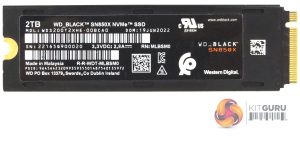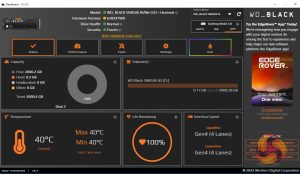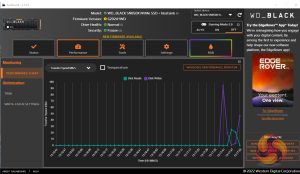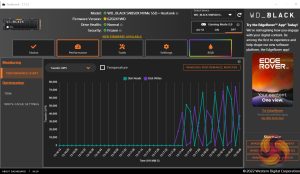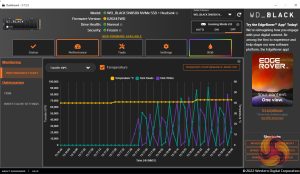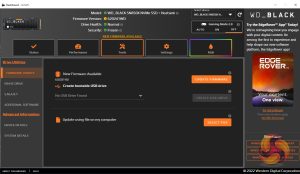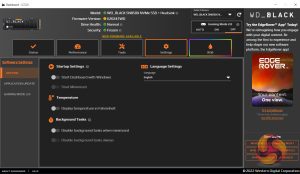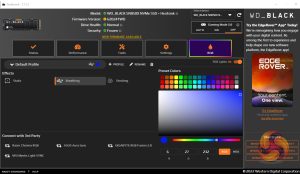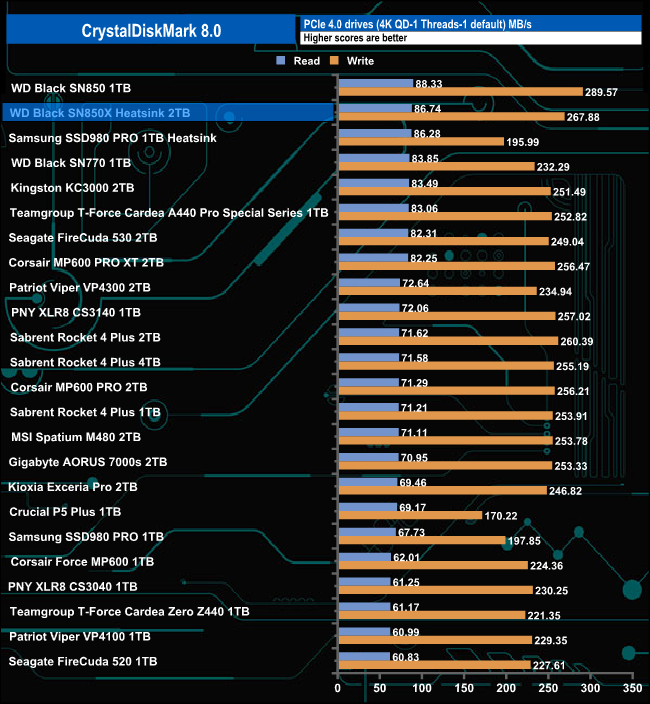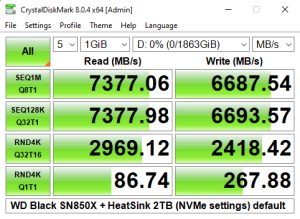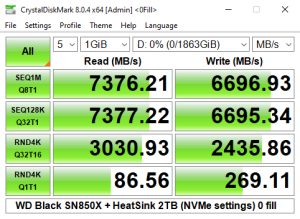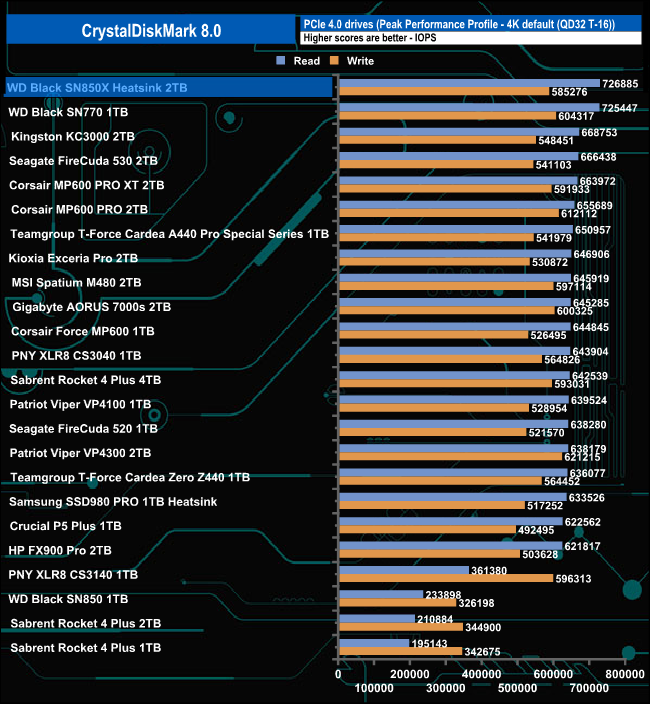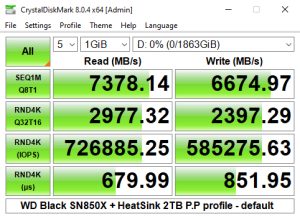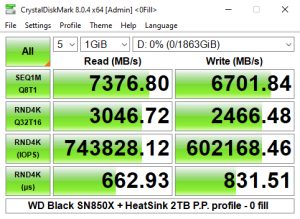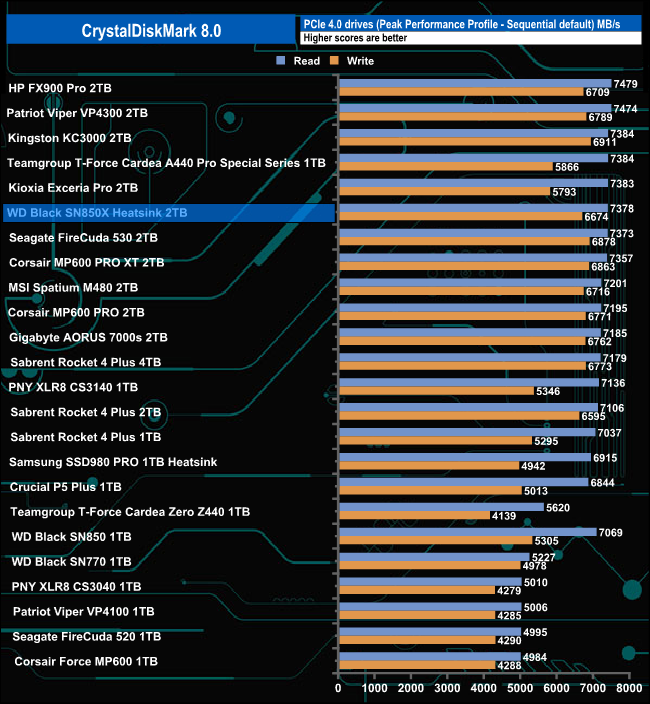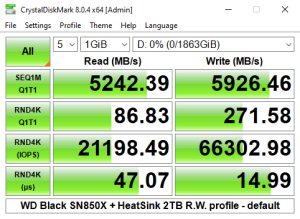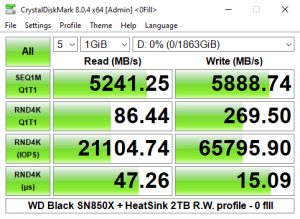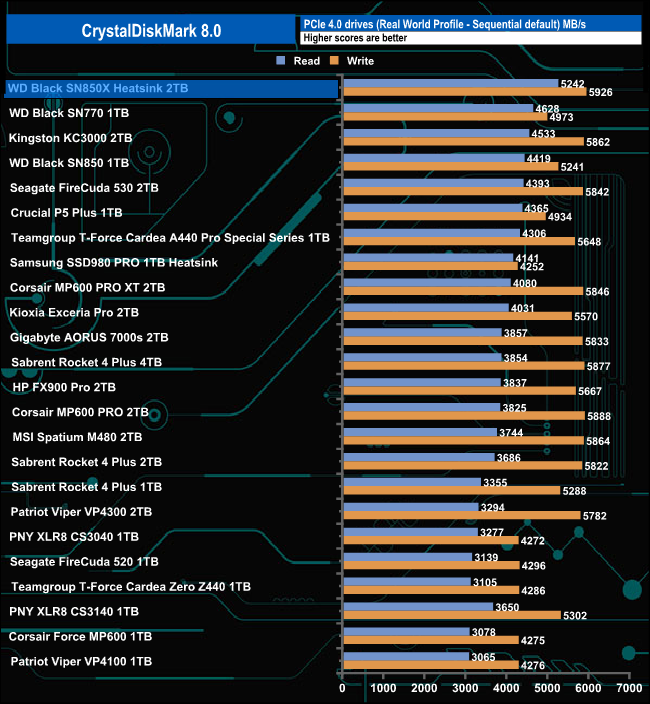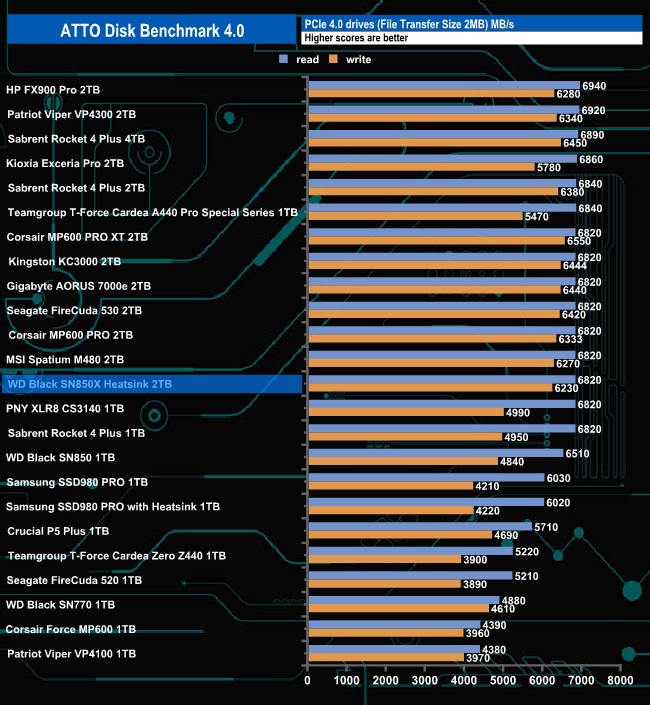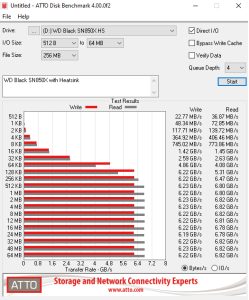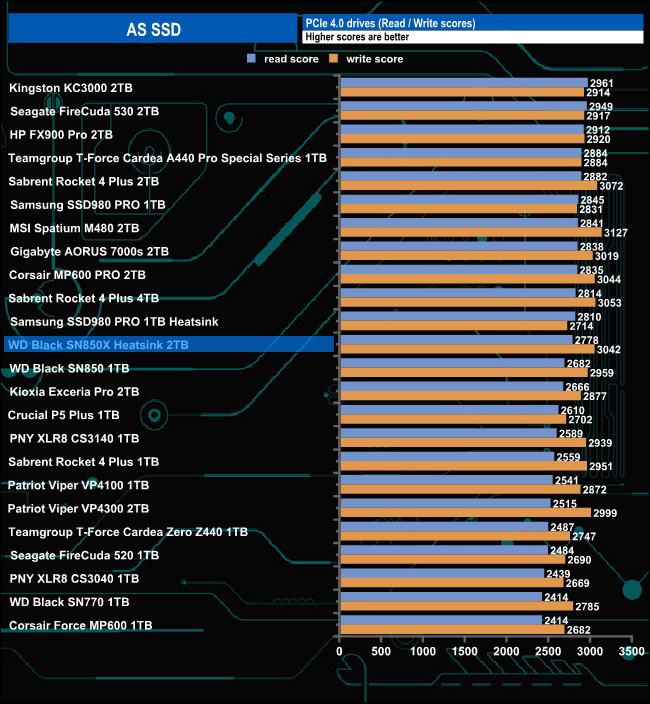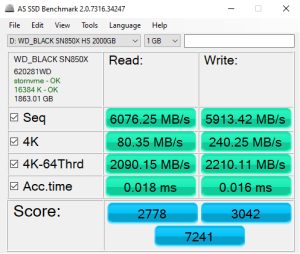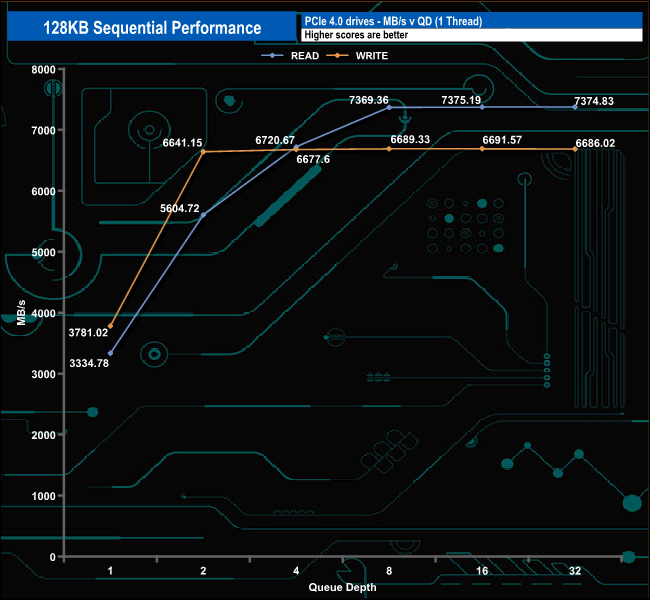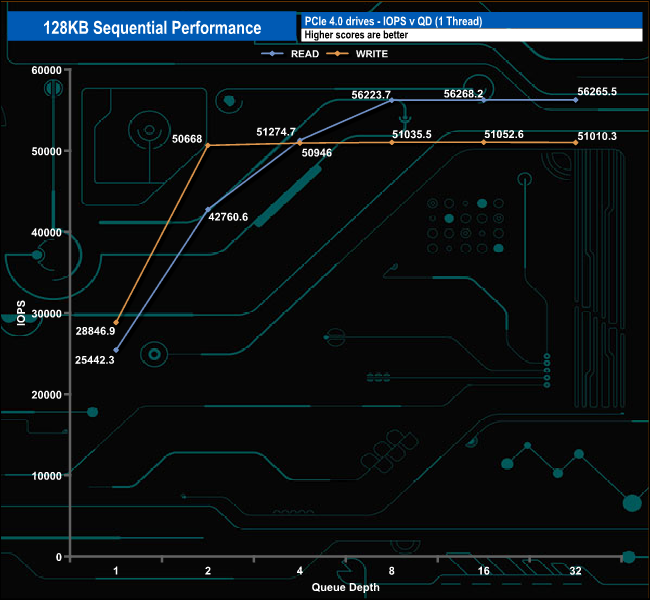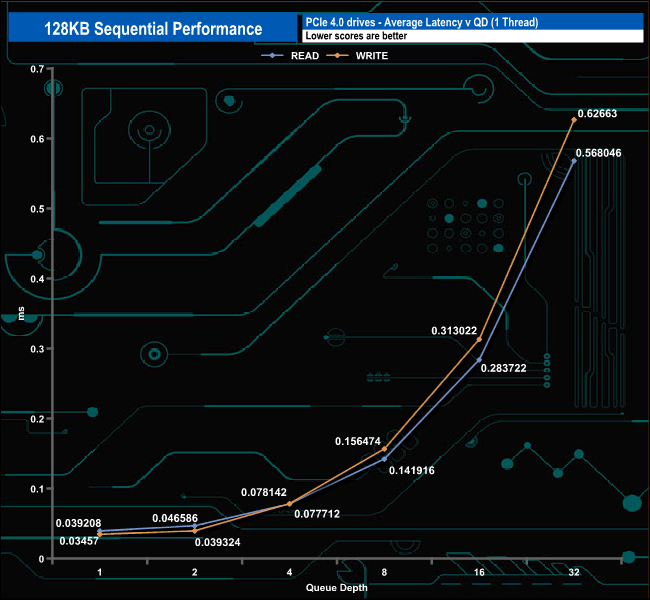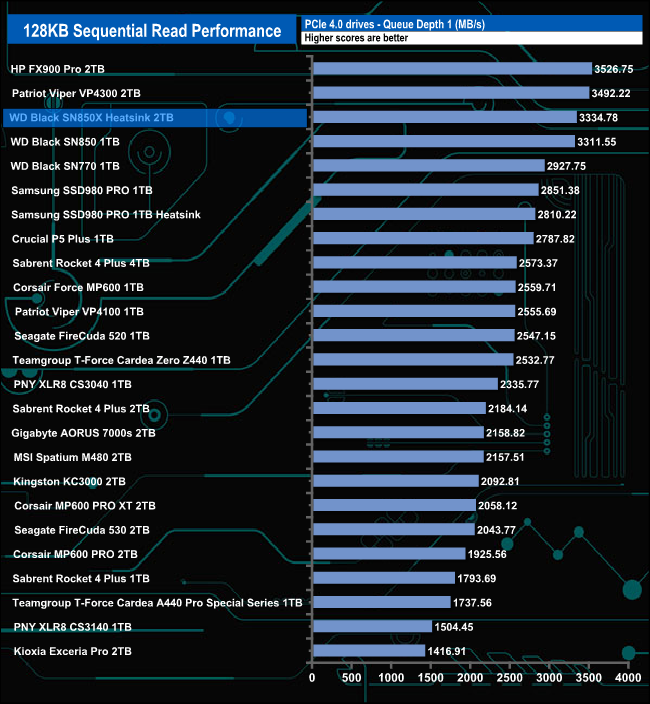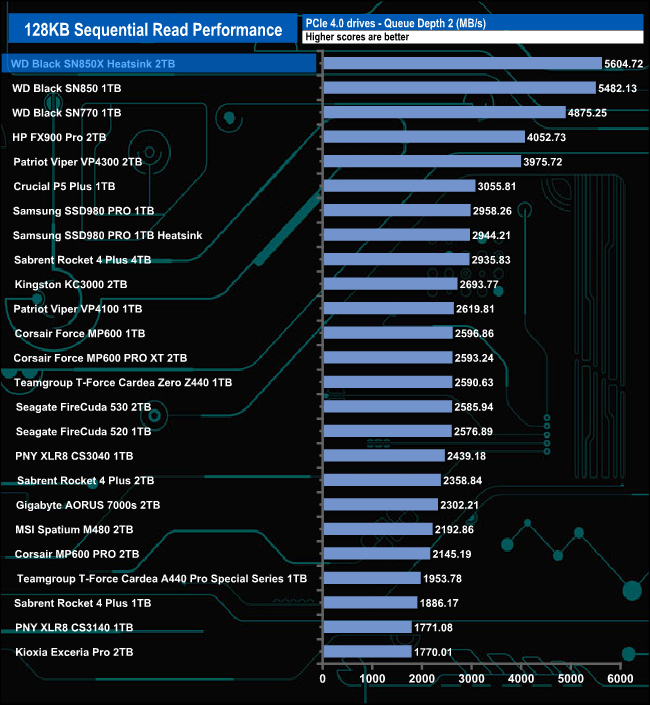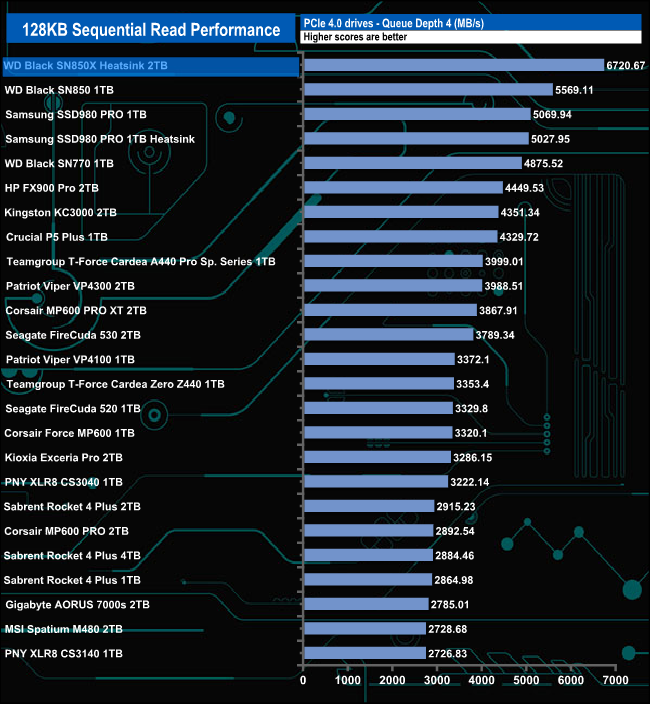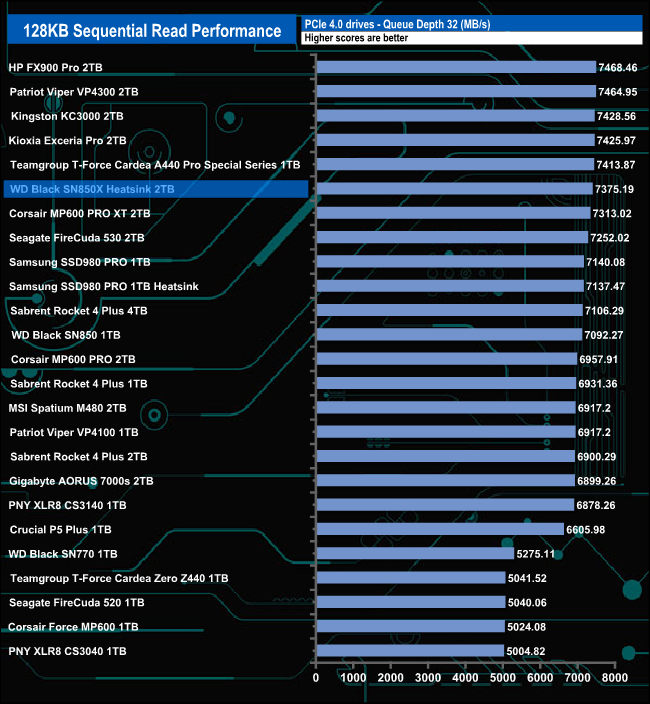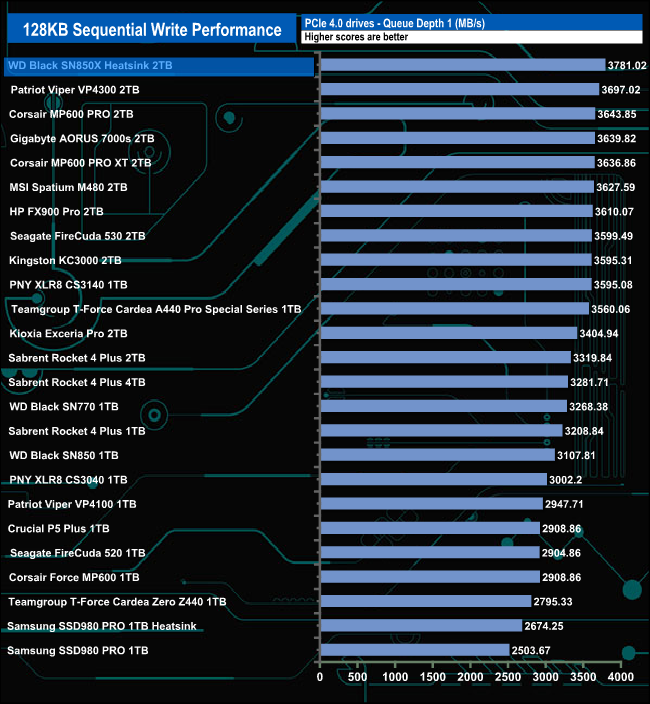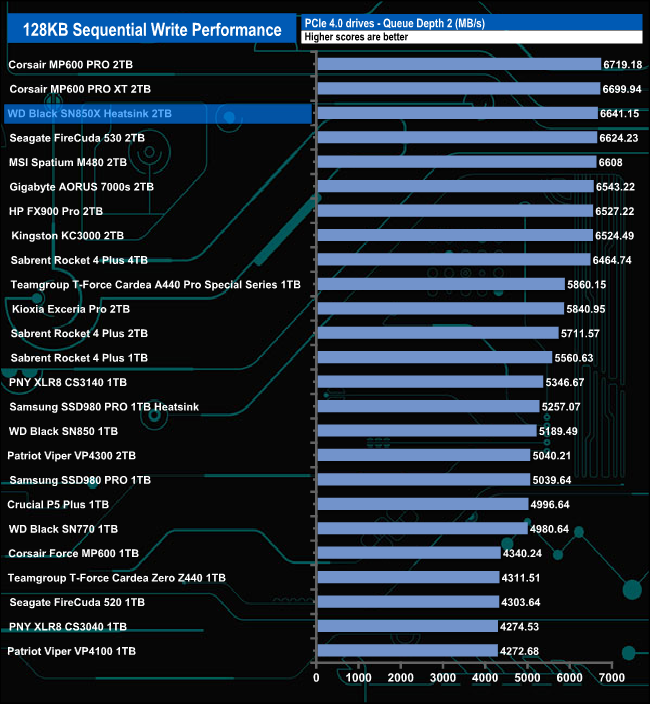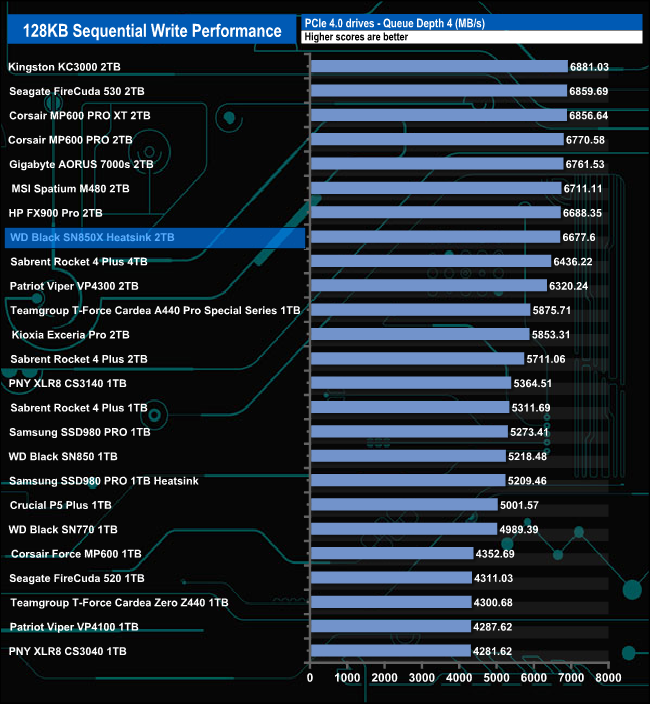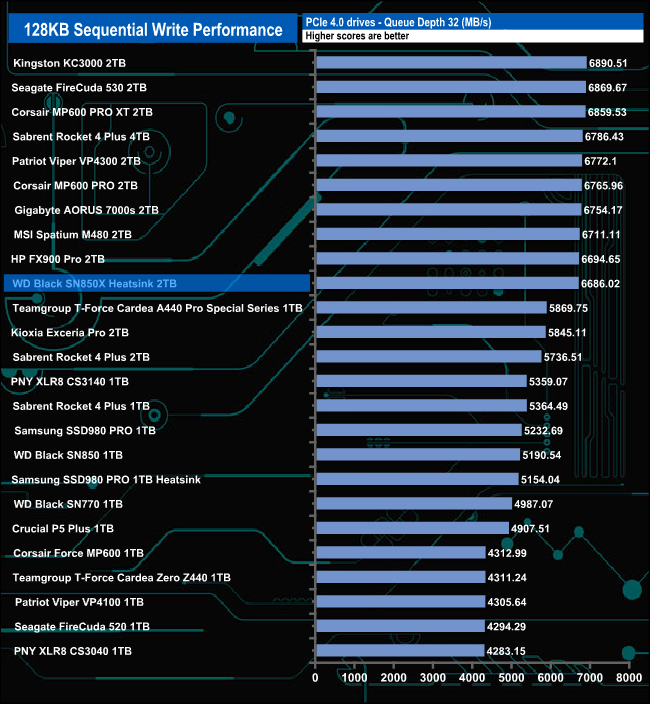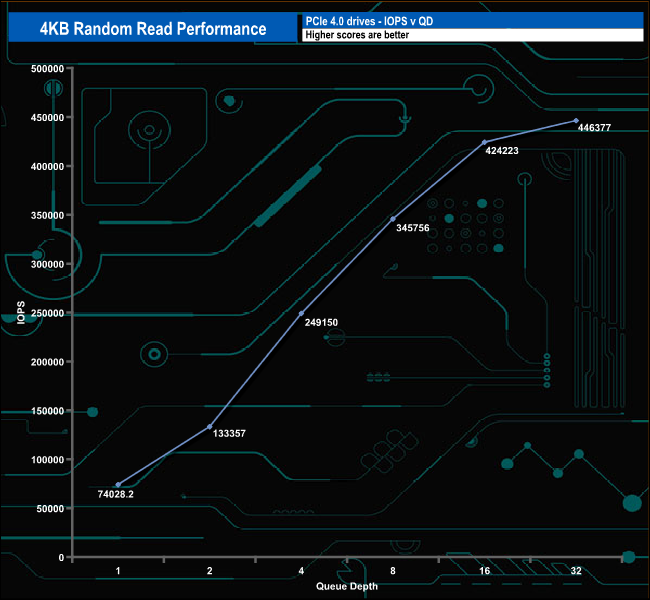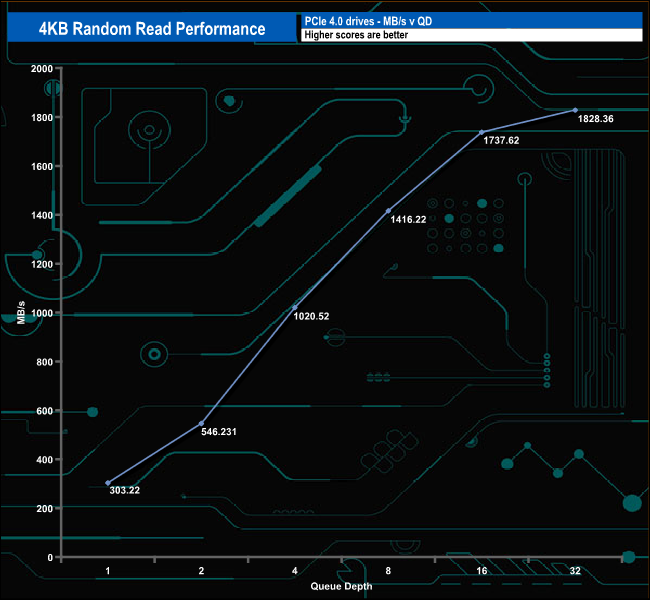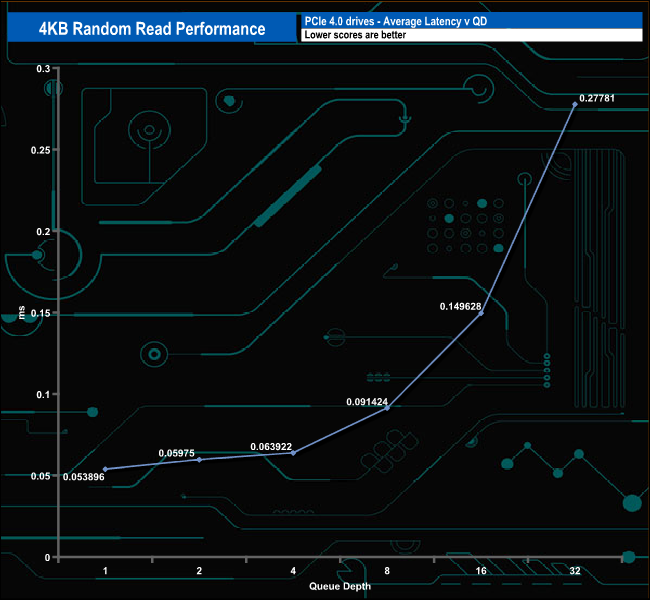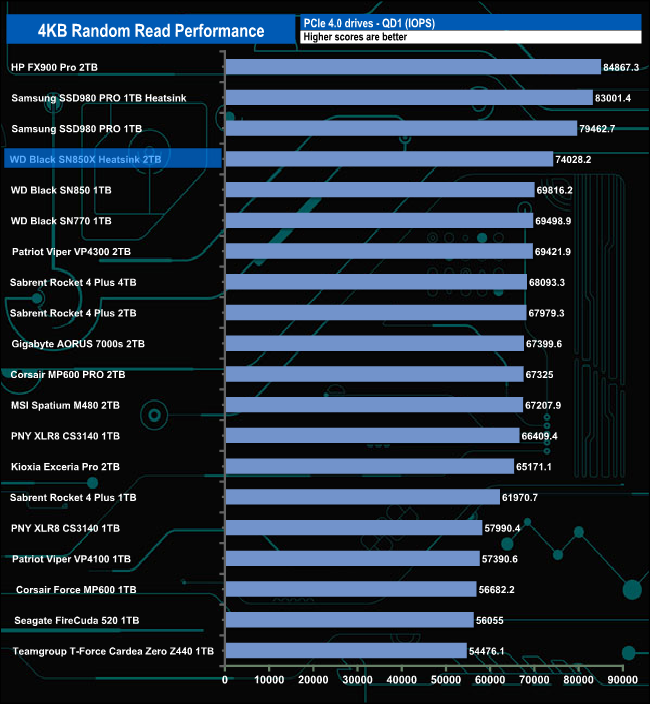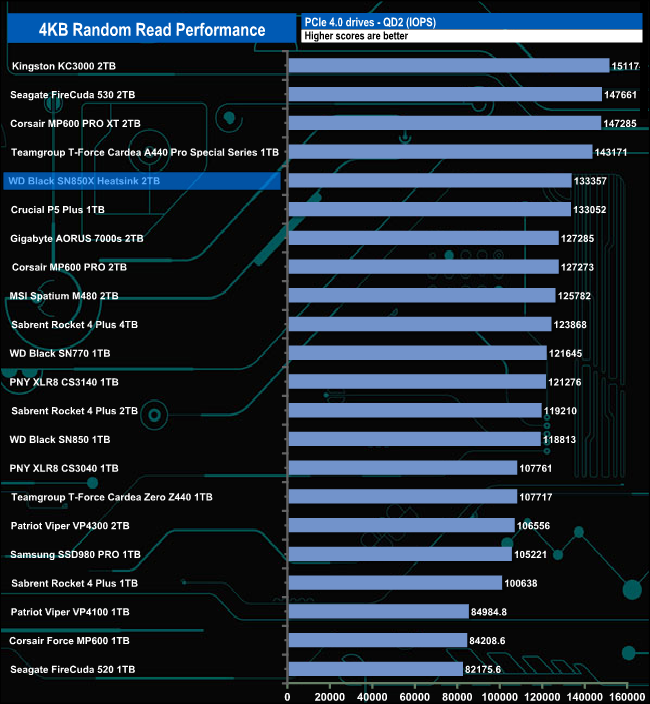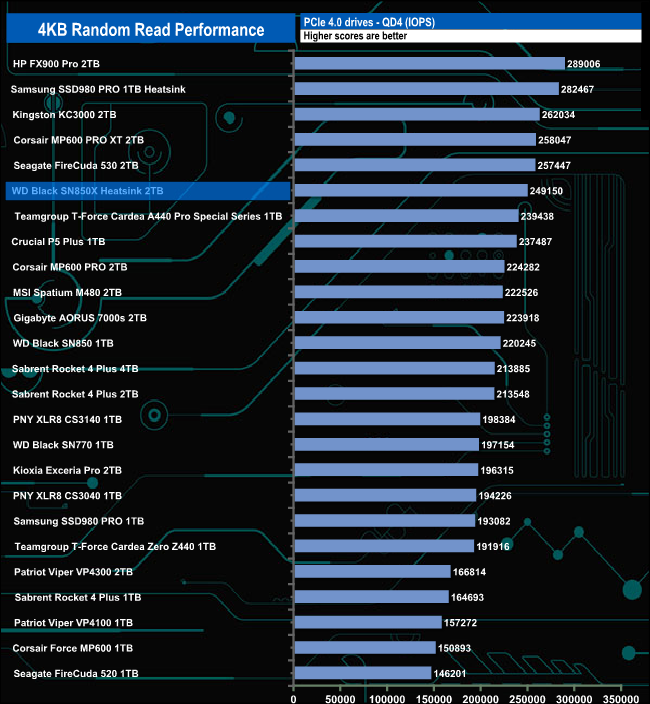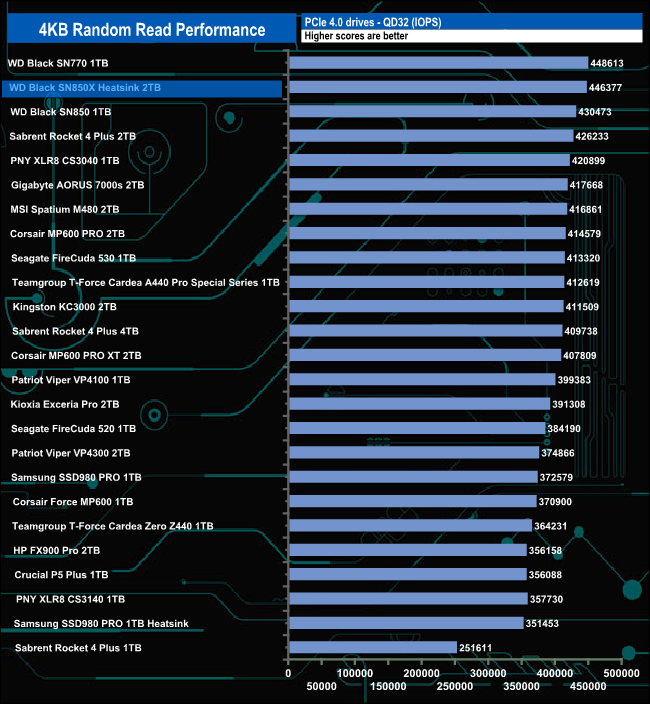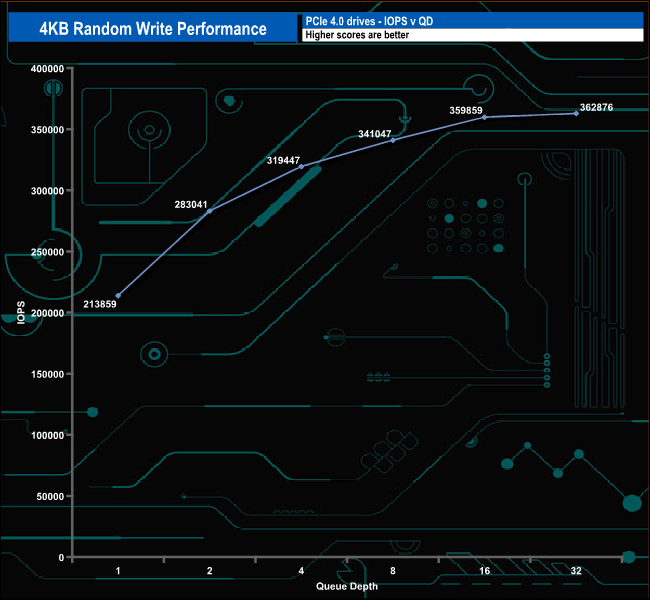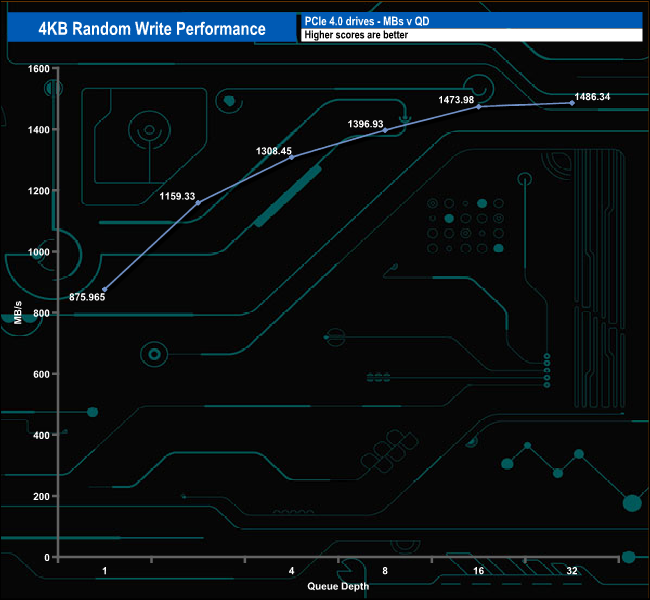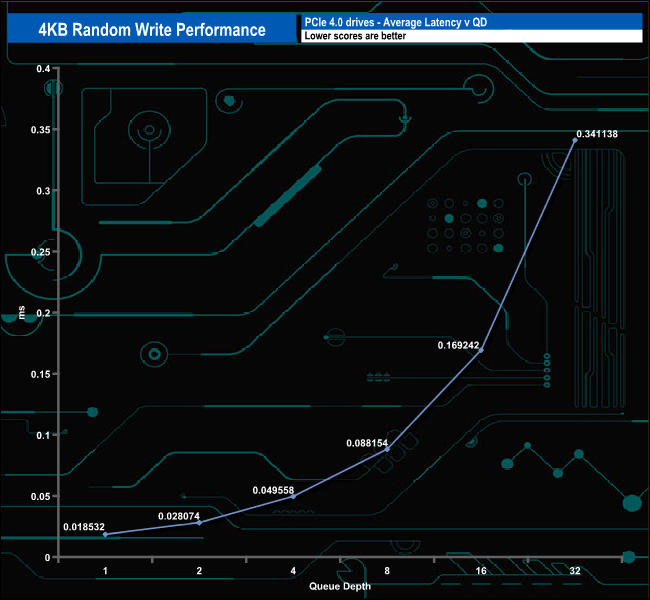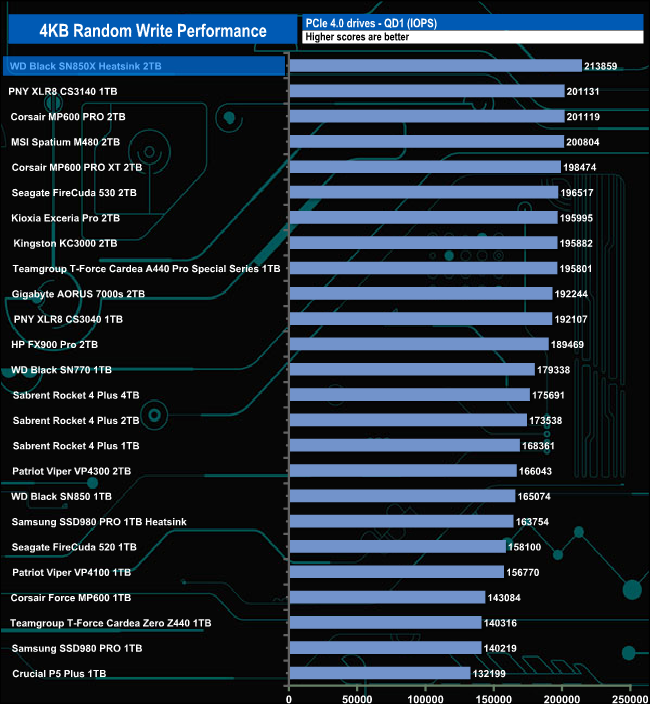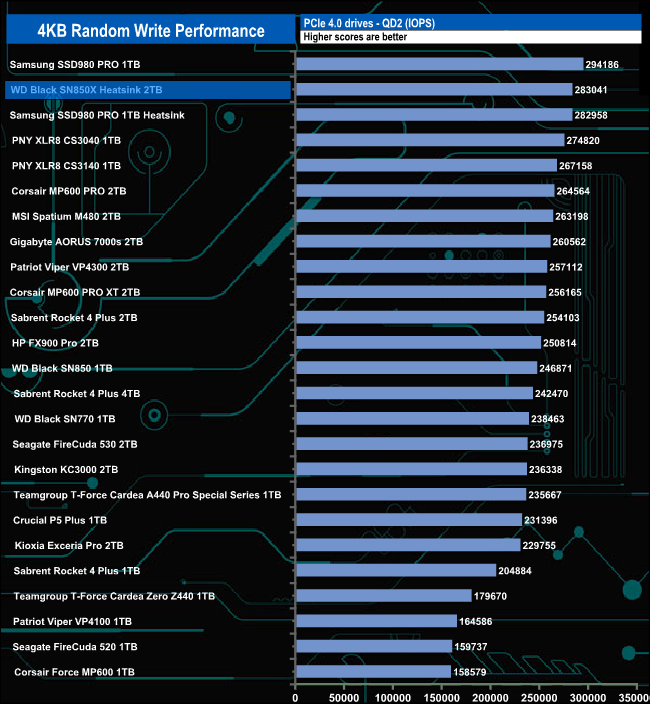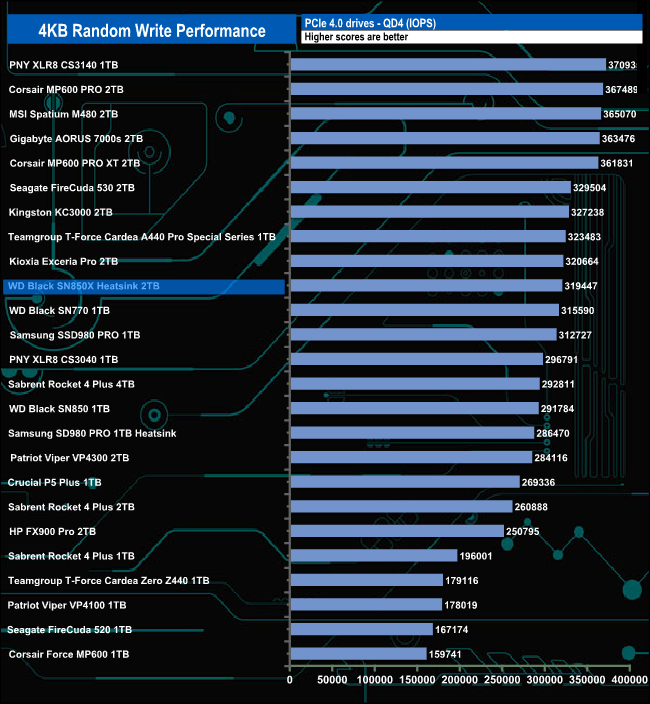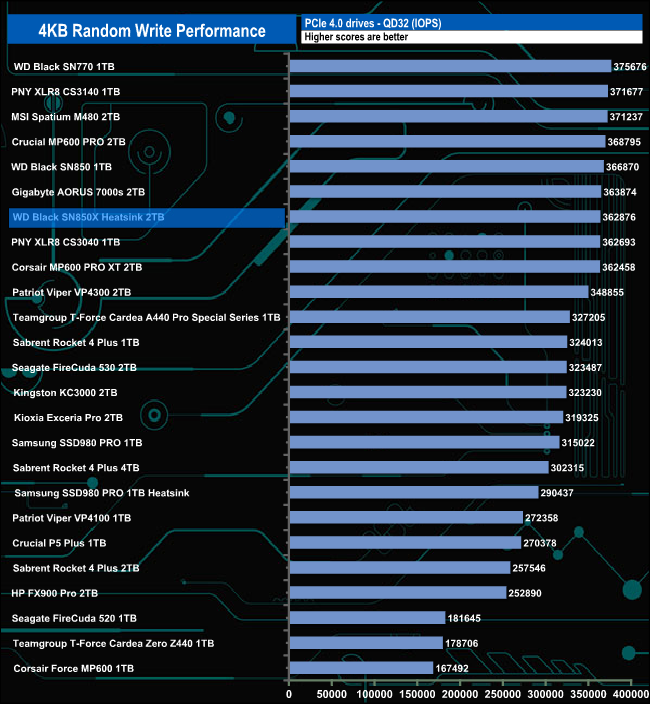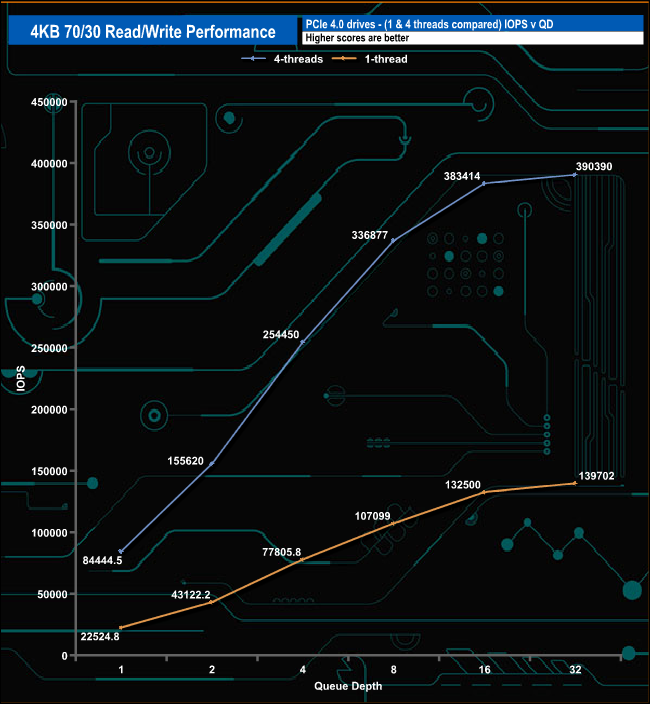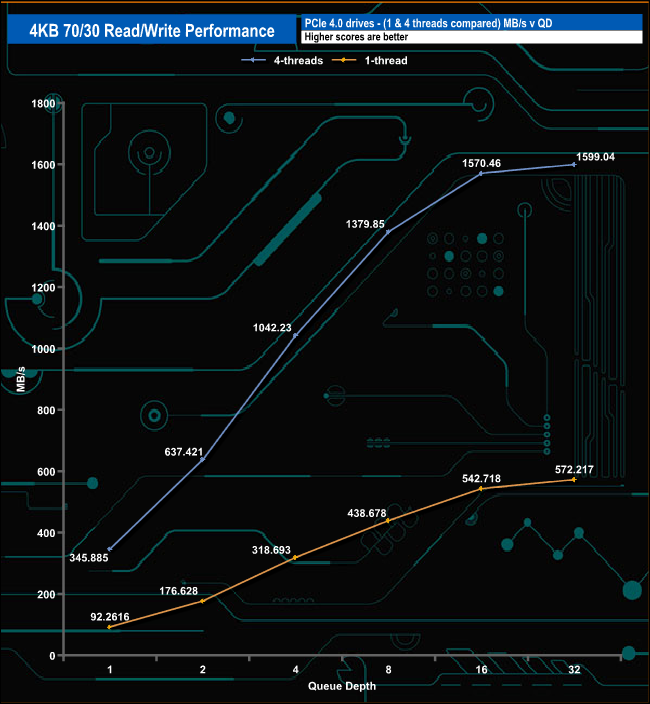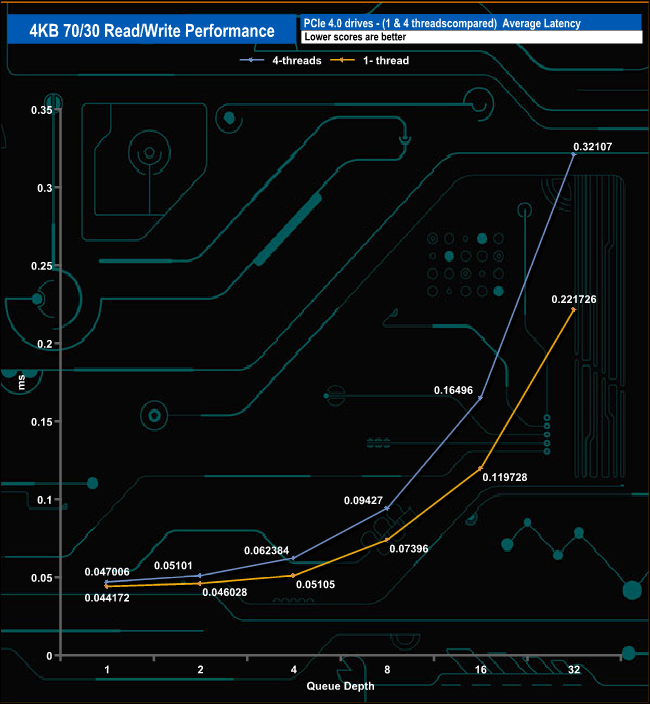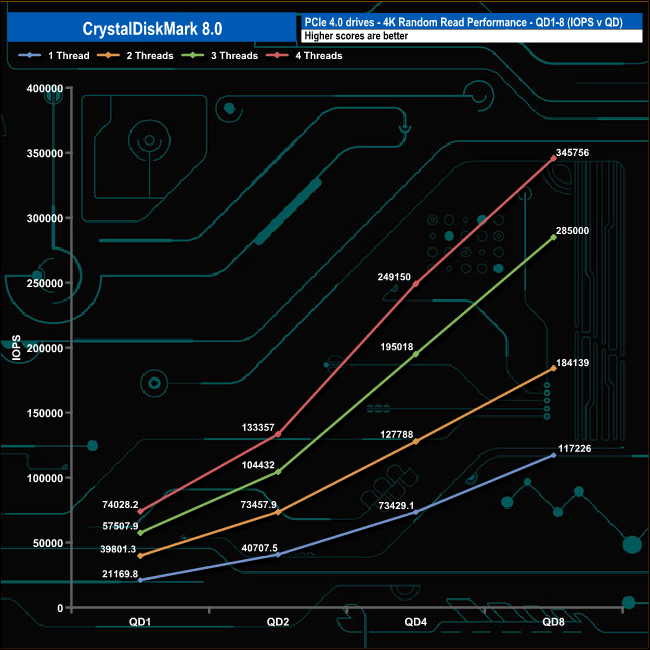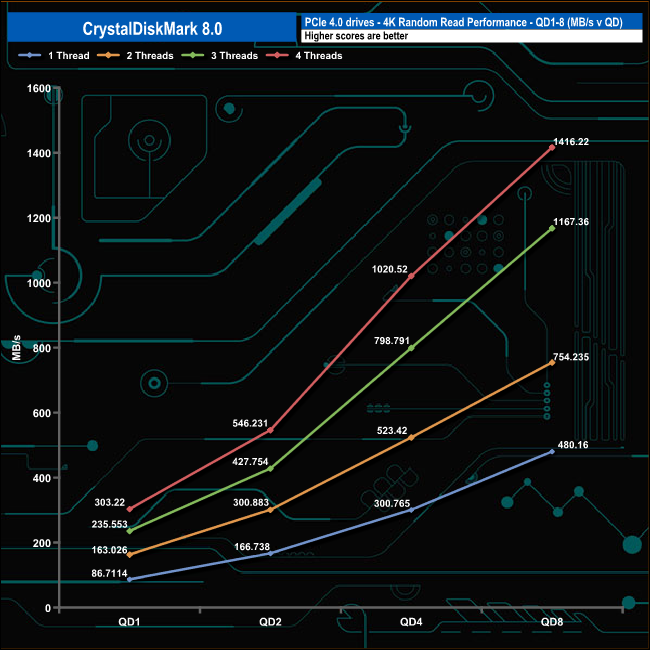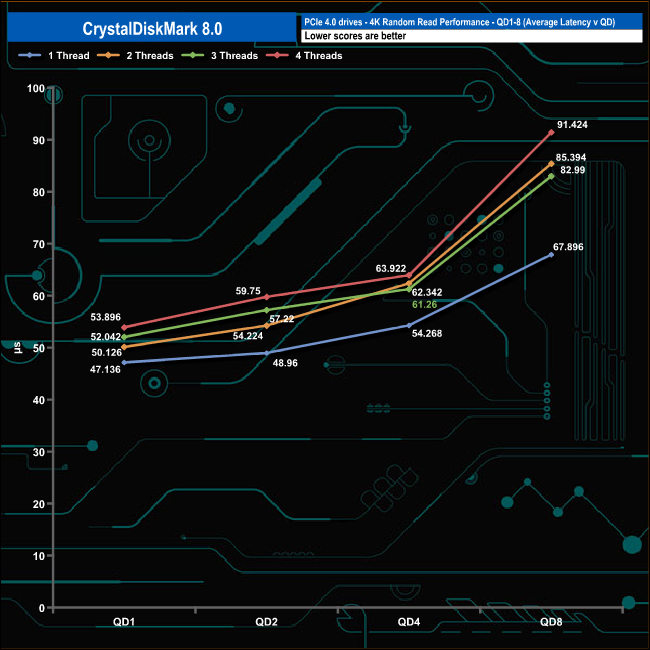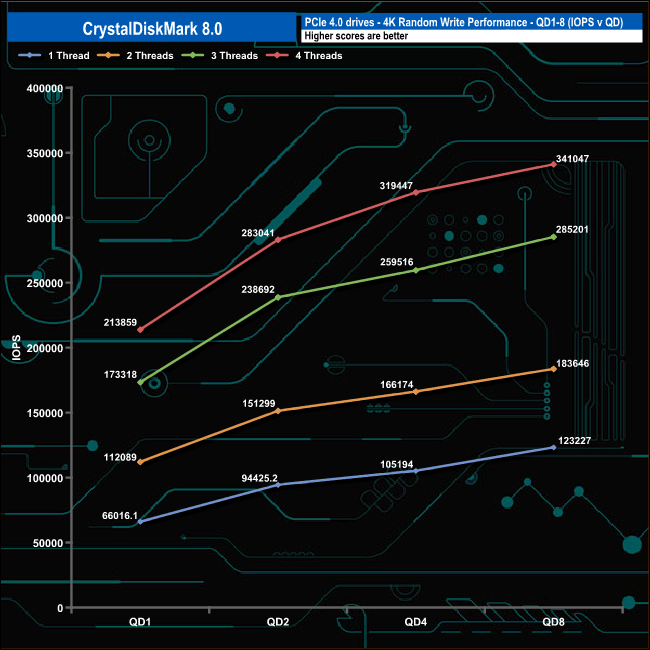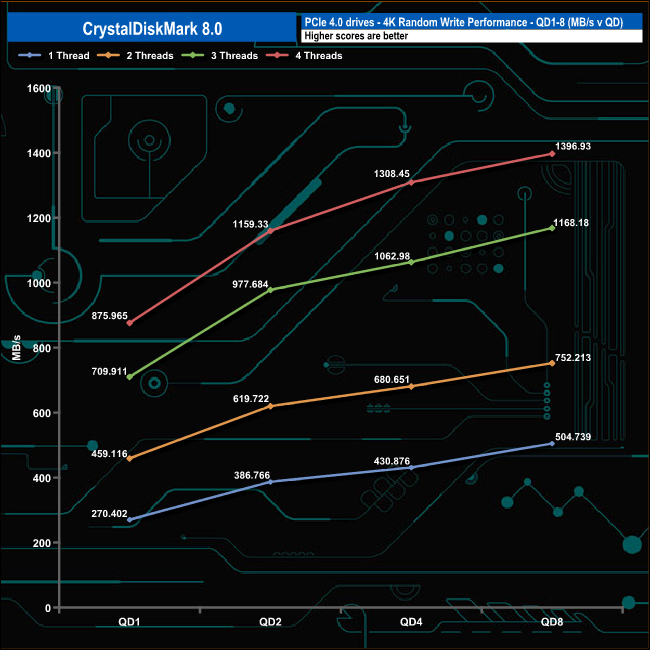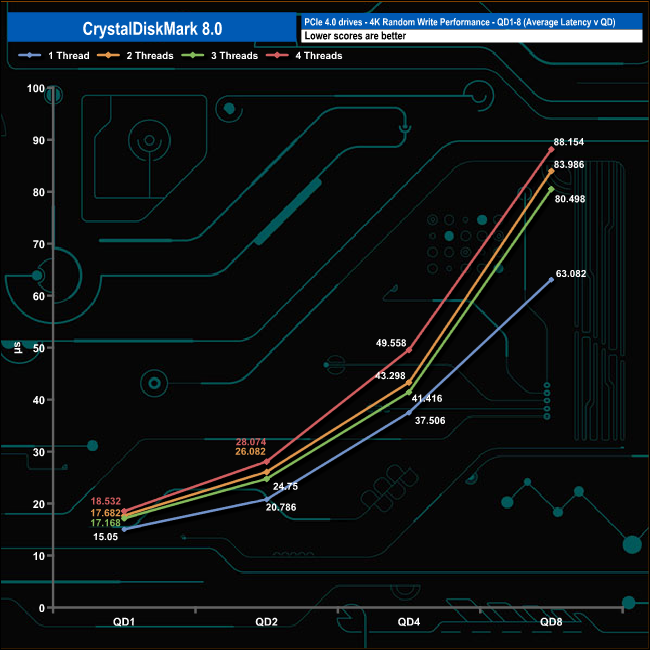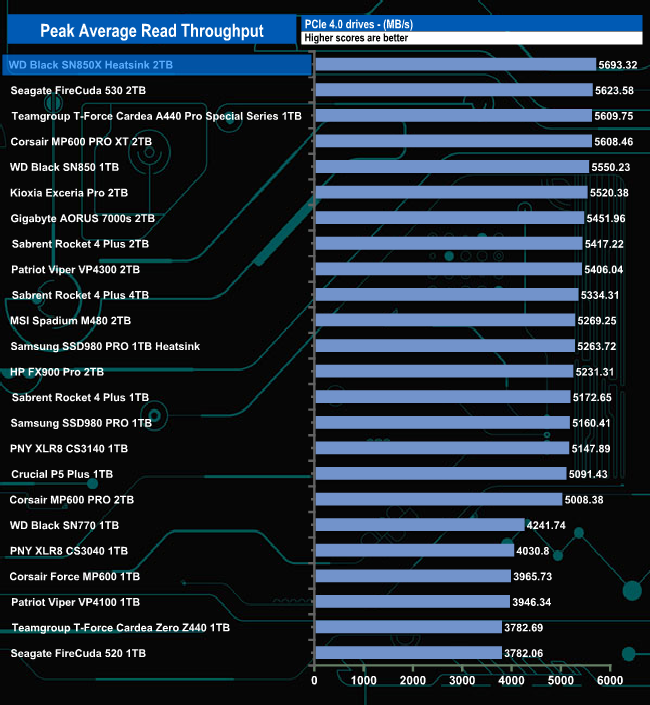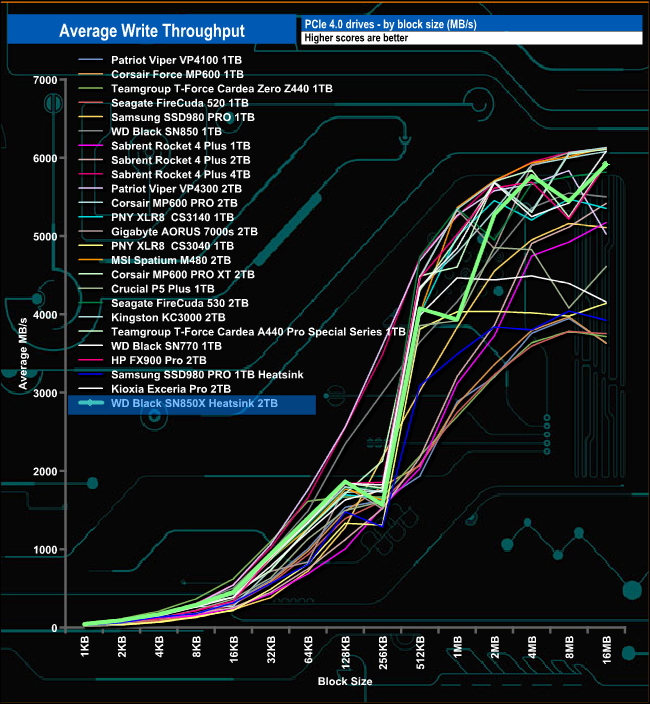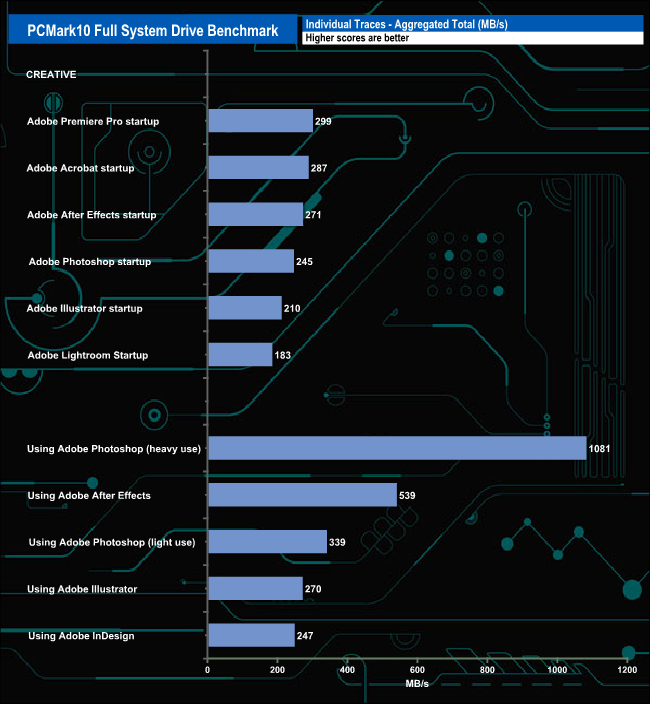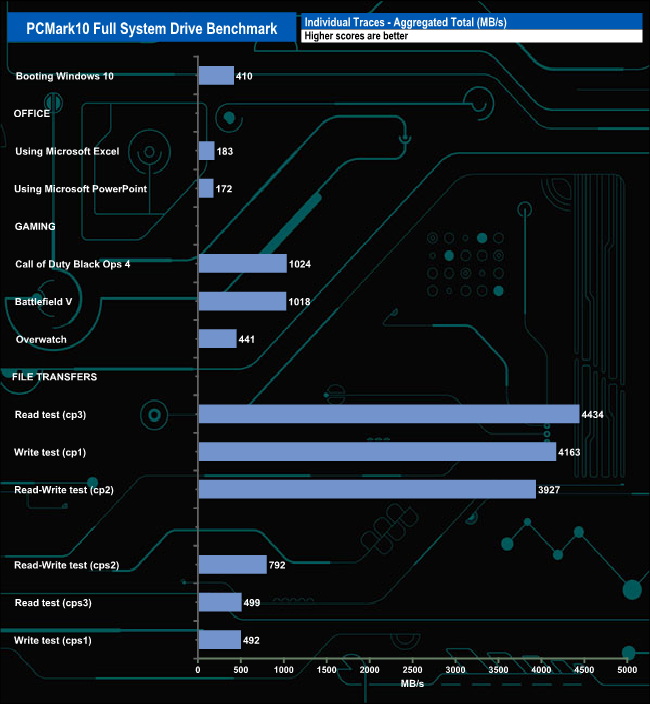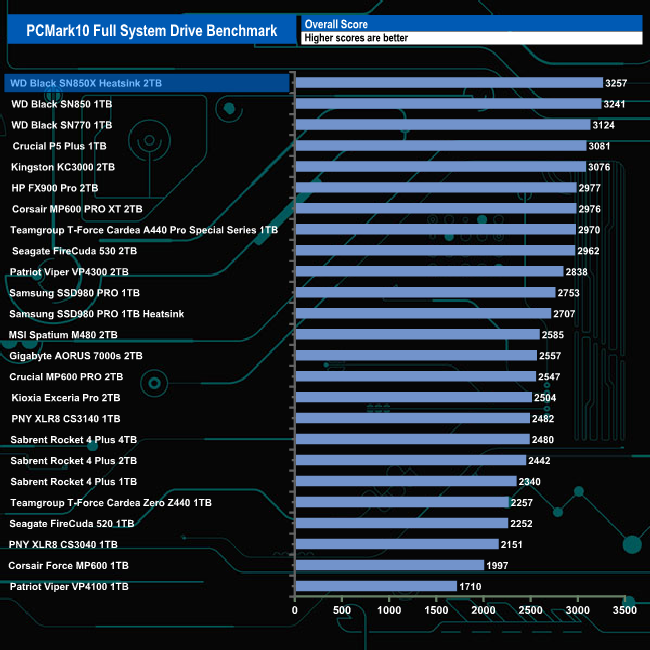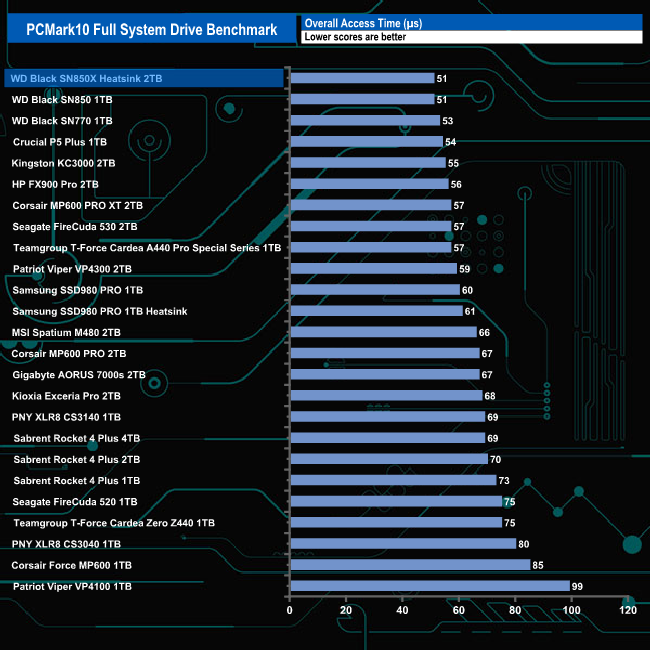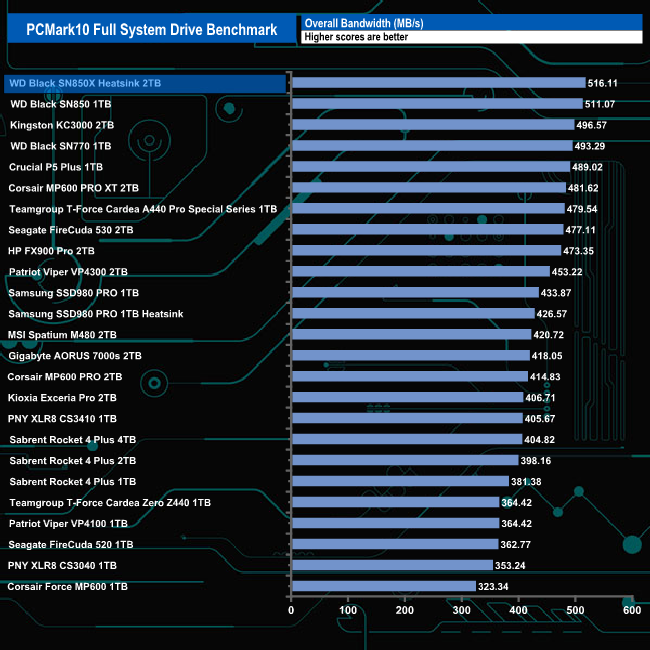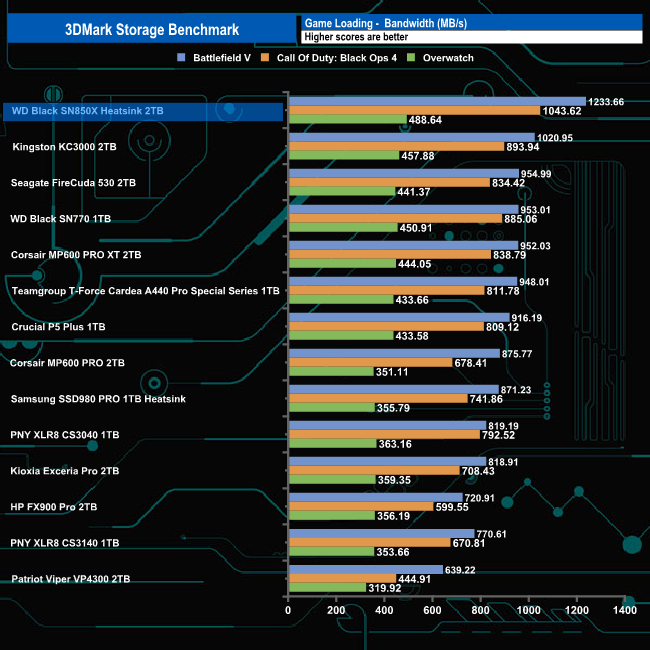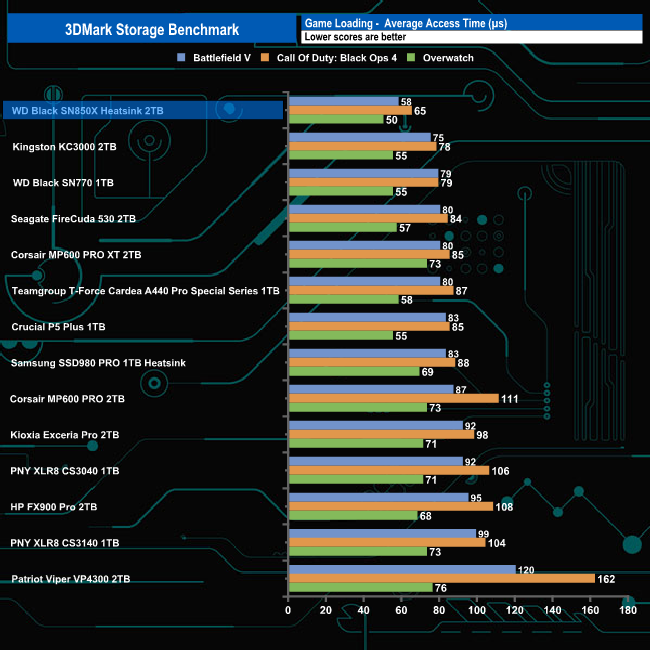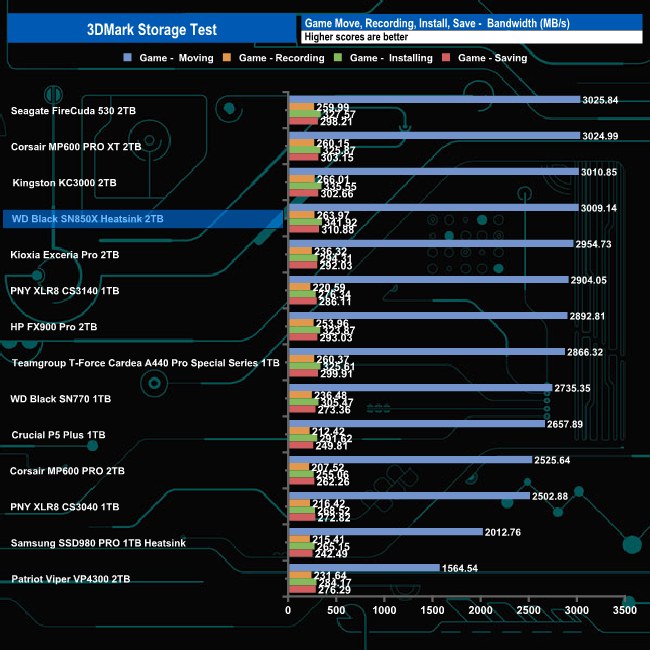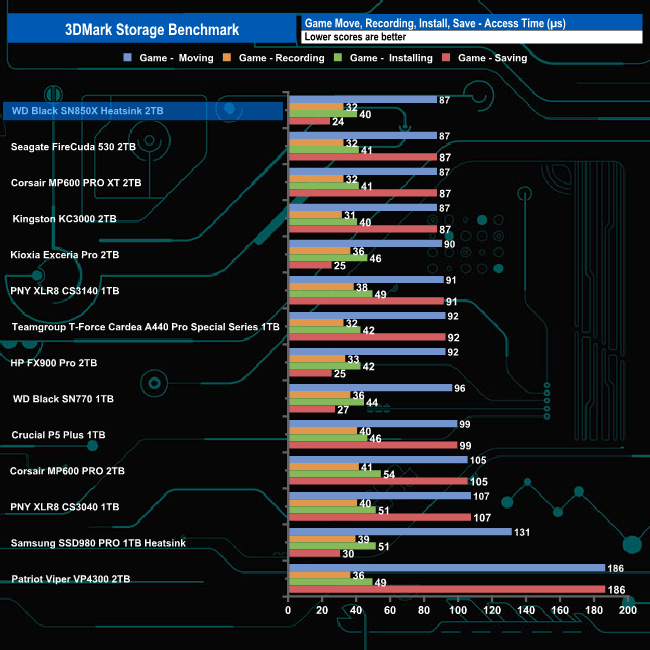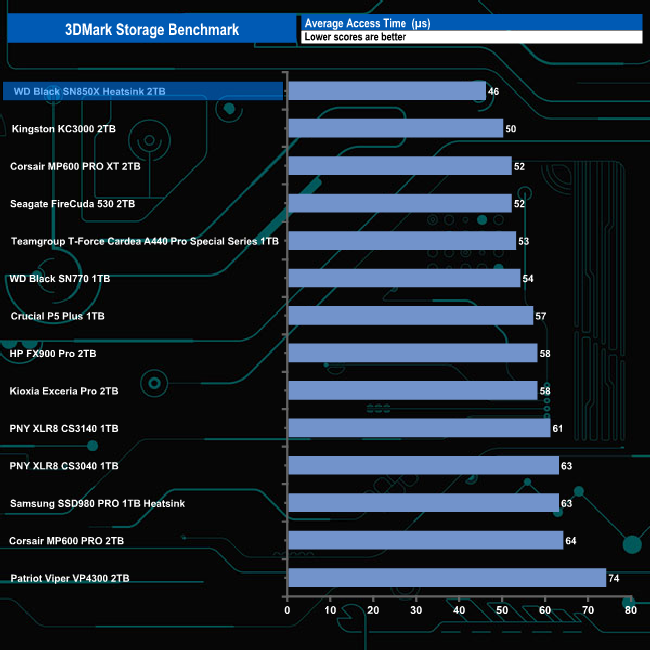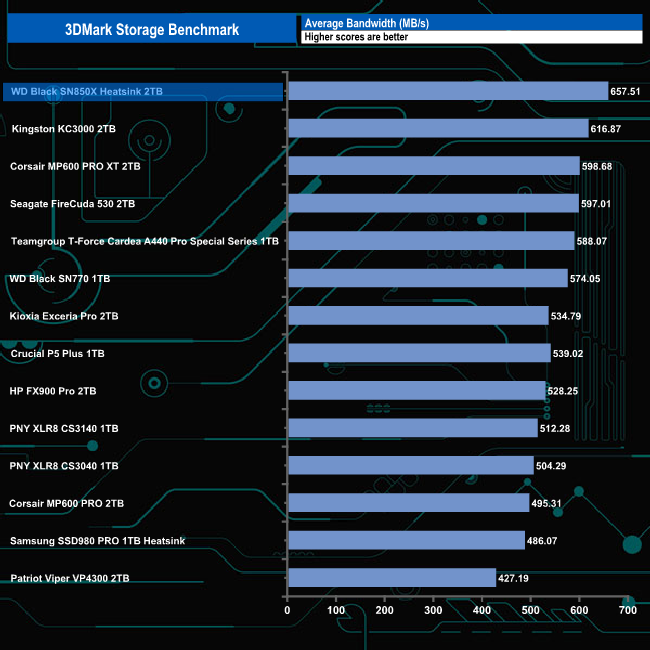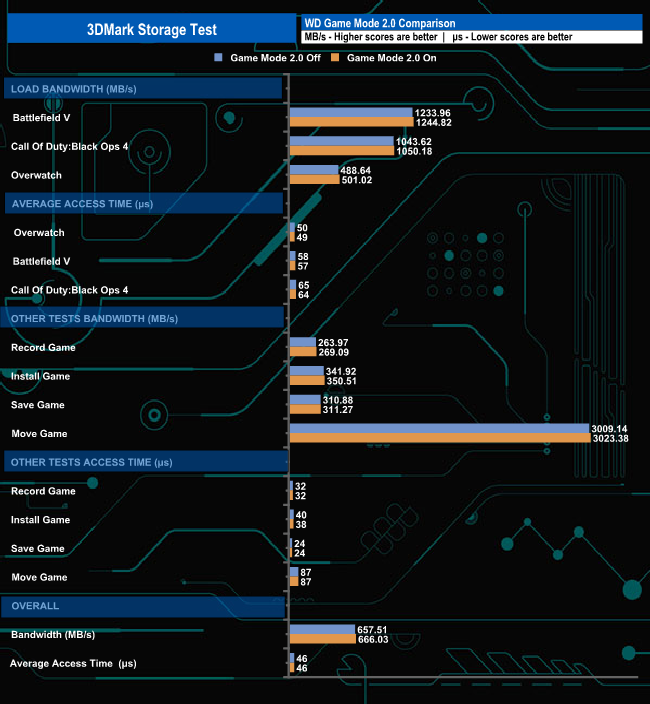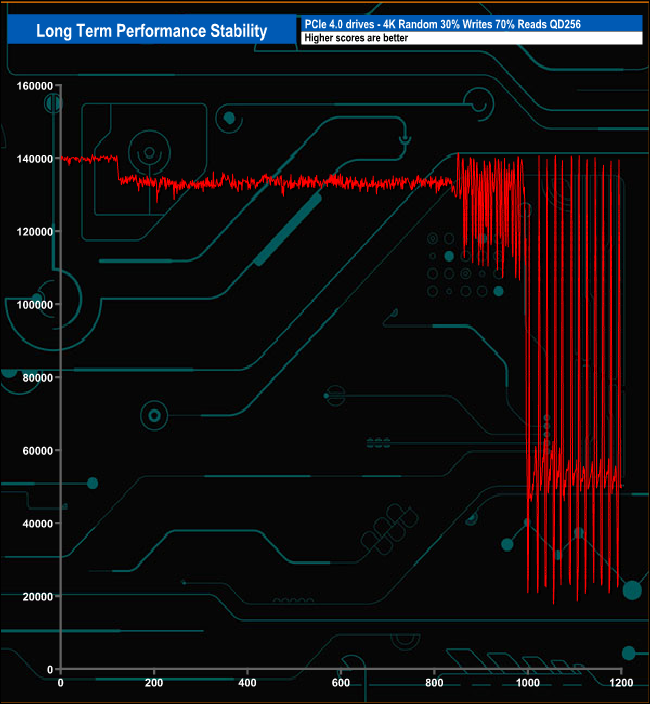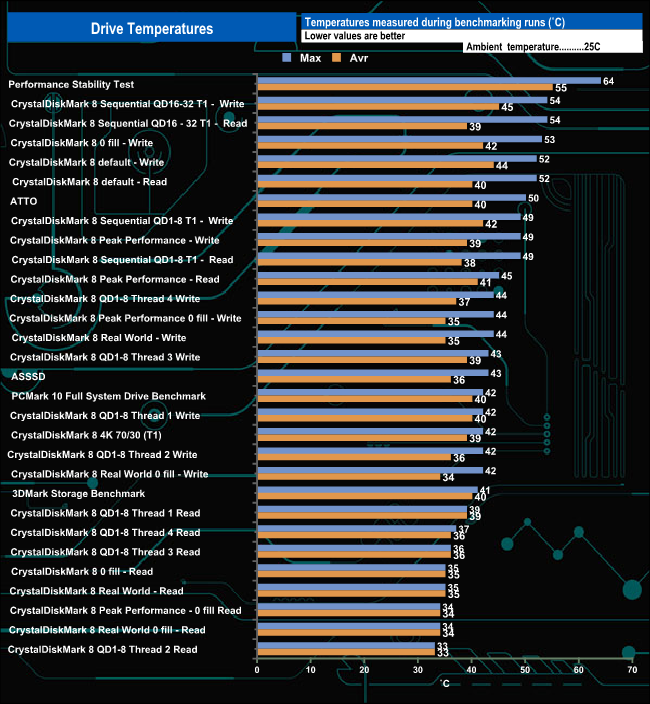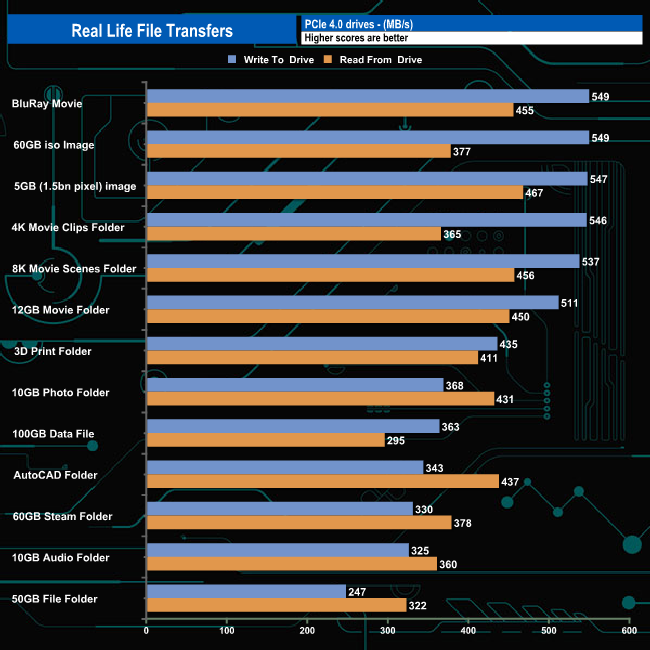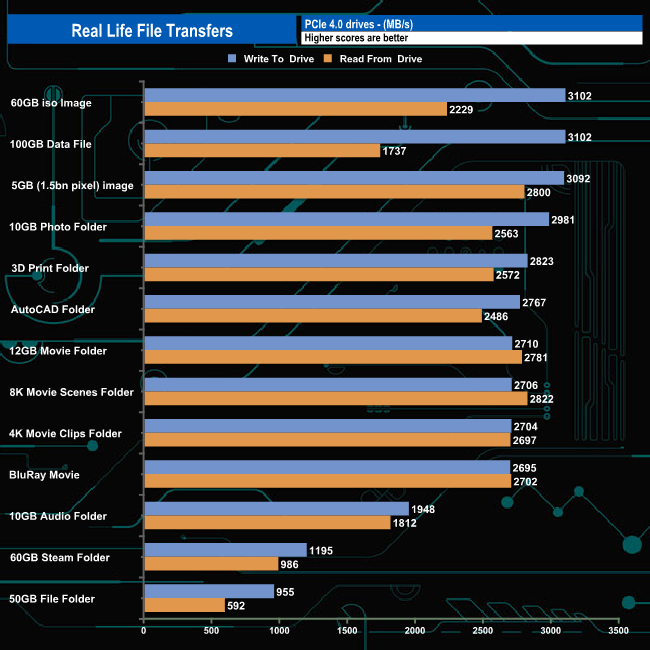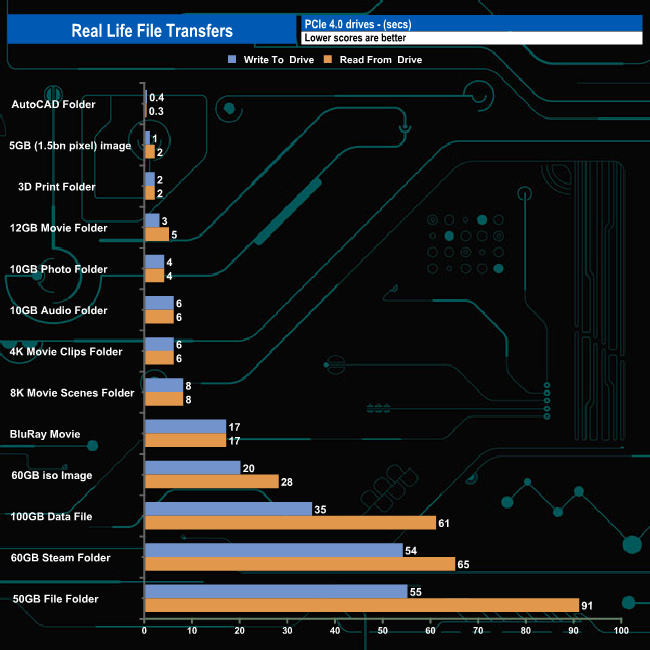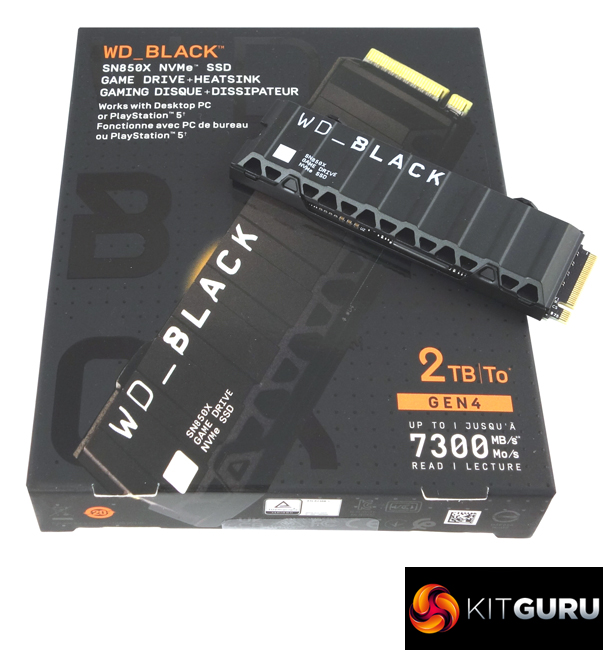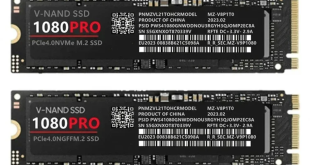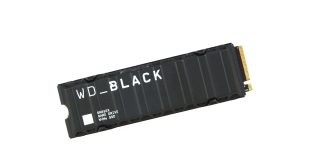
The latest member of WD's Black product line of Gen 4 SSDs is the new SN850X, a successor to the popular Black SN850 that launched a couple of years ago. The new drive uses 112-layer NAND and an updated controller. WD sent us the Heatsink version of the drive, which also features RGB lighting.
The SN850X is (at the time of writing this review) available in three capacities; 1TB, 2TB and a flagship 4TB version. There's also a version of the drive with a heatsink fitted but only for the 1TB and 2TB models (it's the 2TB Heatsink equipped SN850X that we are looking at here). Incidentally, the original SN850 was available in three capacities as well at launch, but starting at 500GB and topping out with a 2TB model
The details surrounding the controller at the time of writing are very thin on the ground (as usual with a WD controller) but at a guess, it's probably an updated version of the in-house G2 controller used in the Black SN850 and the SN770 for that matter. This time around in conjunction with BiCS5 112-layer 3D TLC NAND rather than the 96-layer BiCS4 NAND of the SN850.
When it comes to performance, the SN850X is rated at up to 7,300MB/s for Sequential reads across the board, which is 300MB/s faster than the SN850. Sequential write performance is quoted as up to 6,600MB/s for the 2TB and 4TB models and up to 6,300MB/s for the 1TB drive. That's a very healthy 1,000MB/s increase over the 1TB SN850 while there's an even more impressive 1,500MB/s bump up for the 2TB SN850X over the SN850.
Random read performance for the 4TB and 2TB SN850X is quoted as up to 1.2M IOPS with the 1TB drive making do with 800,000 IOPS. The drive is rated at 1.1M IOPS for all three drives for random writes. As with the Sequential performance these figures are a good deal quicker than the SN850; 2TB & 1TB 1M IOPS random reads, 2TB 710,000 IOPS & 1TB 720,000 IOPS random writes.
Endurance ratings for the SN850X are; 4TB 2,400TBW, 2TB 1,200TBW and 600TBW for the 1TB drive. The 1TB and 2TB figures are the same as the previous SN850. WD backs the drive with a 5-year warranty.
Physical Specifications:
- Usable Capacities: 2TB.
- NAND Components: BiCS5 -112-layer 3D TLC.
- NAND Controller: WD.
- Cache: 2GB LPDDR4.
- Interface: PCIe Gen 4 x4, NVMe 1.4.
- Form Factor: M.2 2280.
- Dimensions: 80 x 23.4 x 8.8mm.
- Drive Weight: 24g.
Firmware Version: 620281WD.
The drive arrives in a smallish box with a clear image of the drive on the front. WD is obviously keen to let you know that this is a fast drive, too, as the 7,300MB/s Sequential read figure is displayed in the bottom right corner of the box. Above this WD highlights the interface the drive uses and its capacity.
The rear of the box has a small clear plastic panel through which part of the drive is visible, sitting in its protective plastic enclosure. To the right of this panel is another image of the drive while to the left of it is that Sequential read figure again, along with the maximum random read IOPS figure. All this information is displayed in English and French. Also on the back of the box is an icon displaying the fact it is supported with a 5-year warranty.
The 2TB SN850X is built on a single-sided M.2 2280 format. Under the full-length compact heatsink sits the WD 8-channel Gen 4 PCIe 4.0 controller, two packages of 112-layer BiCS5 3D TLC NAND and a 2GB DDR4 cache chip. Built into the top edge of the heatsink is the cover over the LEDs for the RGB lightning. It's a very subtle use of RGB as the cover is very small, around 12mm x 2mm and it only supports three effects, Static, Breathing and Strobing.
WD's SSD management utility goes by the name of SSD Dashboard. SSD Dashboard is pretty comprehensive and allows you to monitor drive status, and performance, perform secure erases (currently only by making a bootable USB device), update firmware and monitor temperatures. It also includes a gaming mode which if enabled reduces latency by disabling the low power modes via the firmware.
There’s no cloning tool integrated into the utility but you can download Acronis True Image WD Edition from the WD website.
One page of SSD Dashboard is dedicated to controlling the RGB lighting system which in the case of the SN850X is pretty basic, with just the three effects previously mentioned. Using the SSD Dashboard page you can switch between the three and change the colour behind the effect.
SSD Dashboard also lets you turn on/off WD's Game Mode 2.0 which is only available for Windows currently. The latest version of Game Mode includes an auto mode. When this is selected the system detects game launches and will turn gaming features on; load prediction for faster in-game loading, disabled power saving and adaptive thermal management.
For testing, the drives are all wiped and reset to factory settings by HDDerase V4. We try to use free or easily available programs and some real-world testing so you can compare our findings against your own system. This is a good way to measure potential upgrade benefits.
Main system:
AMD Ryzen 5 3600X, 16GB DDR4-2400, Sapphire R9 390 Nitro and an MSI MPG X570 Gaming Edge Wifi motherboard
Other drives
Corsair MP600 PRO 2TB
Corsair Force MP600 1TB
Corsair MP600 PRO XT 2TB
Crucial P5 Plus 1TB
Gigabyte AORUS 7000e 2TB
HP FX900 Pro 2TB
Kingston KC3000 2TB
Kioxia Exceria Pro 2TB
MSI Spatium M480 2TB
Patriot Viper VP4300 2TB
Patriot Viper VPN4100 1TB
PNY XLR8 CS3040 1TB
PNY XLR8 CS3140 1TB
Sabrent Rocket 4 Plus 1TB
Sabrent Rocket 4 Plus 2TB
Sabrent Rocket 4 Plus 4TB
Samsung SSD980 PRO 1TB
Samsung SSD980 PRO Heatsink 1TB
Seagate FireCuda 520 1TB
Seagate FireCuda 530 2TB
Teamgroup T-Force Cardea Zero Z440 1TB
Teamgroup T-Force Cardea A440 Pro Special Series 1TB
WD Black SN770 1TB
WD Black SN850 1TB
Software:
Atto Disk Benchmark 4.
CrystalMark 8.0.0.
AS SSD 2.0.
PC Mark 10.
3D Mark Storage Benchmark.
All our results were achieved by running each test five times with every configuration this ensures that any glitches are removed from the results. Trim is confirmed as running by typing fsutil behavior query disabledeletenotify into the command line. A response of disabledeletenotify =0 confirms TRIM is active.
CrystalDiskMark is a useful benchmark to measure theoretical performance levels of hard drives and SSD’s. We are using v8.0.
When we tested the Black SN850X with CrystalDiskMark 8's 4K QD1 1 Thread test we got read (86.74MB/s) and write (267.88MB/s) results that were a little slower than what we saw for the Black SN850 drive.
We could however confirm the official maximum read/writes speeds (7,300MB/s and 6,600MB/s respectively) with a read test result of 7,377MB/s (default) and 6,696MB/s (0 fill) for writes.
The Sequential read result of 7,377MB/s puts the drive into the top five of Gen 4 consumer drives we've tested to date
Switching over to the default Peak Performance profile we saw a 4K random read best of 726,685 IOPS with a write result of 582,276 IOPS, both well short of the official 1.2M IOPS and 1.1M IOPS maximums. However, while we didn't get close to the official figures, that 726,885 IOPS read figure is the fastest we've seen to date for consumer Gen4 NVMe SSD. Using the 0 fill (compressible data) tests we saw improvements in both the read (743,828 IOPS) and write (602,168 IOP) performance.
Using the Real World profile sees the drive topping the Sequential results chart with a read score of 5,242MBs with writes at an impressive 5,926MB/s.
The ATTO Disk Benchmark performance measurement tool is compatible with Microsoft Windows. Measure your storage systems performance with various transfer sizes and test lengths for reads and writes. Several options are available to customize your performance measurement including queue depth, overlapped I/O and even a comparison mode with the option to run continuously. Use ATTO Disk Benchmark to test any manufacturer's RAID controllers, storage controllers, host adapters, hard drives and SSD drives and notice that ATTO products will consistently provide the highest level of performance to your storage.
We are using version 4.0 for our NVMe disk tests.
Using the ATTO benchmark, the best Sequential performance we saw from the drive was 6,820MB/s for reads and 6,230MB/s for writes, someway short of the official maximums of 7,300MB/s and 6,600MB/s for reads and writes respectively. While the results were not as good as the official figures they are stronger than the results we saw from the previous Black SN850.
AS SSD is a great free tool designed just for benching Solid State Drives. It performs an array of sequential read and write tests, as well as random read and write tests with sequential access times over a portion of the drive. AS SSD includes a sub suite of benchmarks with various file pattern algorithms but this is difficult in trying to judge accurate performance figures.
In the AS-SSD benchmark, the WD Black SN850X did seem to lag behind a good selection of its competitors as its read score of 2778 is only good enough to put the drive into a mid-table position in our results chart unlike the write score of 3042, which is much stronger.
We used CrystalDiskMark 8‘s custom settings to test the Sequential read and write performance of the drive through a range of queue depths. The setup for the tests is listed below.
128KB Sequential Read / Write.
Transfer Request Size: 128KB, Thread(s): 1, Outstanding I/O: 1-32.
WD rate the Sequential performance of the 2TB Black SN850X as up to 7,300MB/s for reads and up to 6,600MB/s for writes. Using the custom settings option in CrystalDiskMark 8 we could confirm both official read and write figures with test run results of 7,374.83MB/s and 6,686.02MB/s respectively.
128KB Sequential Read v QD performance compared.
In comparison to the drives around it, the 2TB WD Black SN850X performs best in our Sequential Read tests at QD's 2 & 4 where it tops the charts with results of 5,604.72MB/s and 6,720.67MB/s respectively. At QD1 it sits in third place while at QD32 it drops to sixth.
128KB Sequential Write v QD performance compared.
When it comes to Sequential write performance, the drive performs at its best at QD1 where it tops the chart with a test result of 3,781MB/s. As the queue depth deepens the drive drops down the table, finishing our test run at QD32 (6,686MB/s) with the drive at a mid-table position.
We used CrystalDiskMark 8‘s custom settings to test the 4K random read performance of the drive through a range of queue depths. The setup for the tests is listed below.
Transfer Request Size: 4KB, Outstanding I/O: 1-32.
The official maximum 4K random read figure for the drive is 1.2M IOPS. Using our four threaded tests, the best we saw from the tested drive was 446,377 IOPS nowhere close to the official rating. We did a quick test of the drive using eight threads and got a best test result of 648,467.6 IOPS, still miles away from the official figure.
4K Random Read v QD Performance.
At QDs 1, 2 & 4 the drive hovers around the top five of the drives we've tested to date. However at QD32, the 446,377 IOPS figure from the drive sees it in second place in the chart behind another WD Black drive, the SN770.
We used CrystalDiskMark 8‘s custom settings to test the 4K random write performance of the drive through a range of queue depths. The setup for the tests is listed below.
Transfer Request Size: 4KB, Outstanding I/O: 1-3
As with the 4K random read tests, the random write test results are well short of the official 1.1M IOPS, peaking at 362,876 IOPS (QD32). As with the random reads, we ran a test using eight threads at QD32 to see if we could closer to the official figure. The best we saw from the drive was 464,466 IOPS, an improvement, but nowhere close to the official figure.
4K Random Write v QD Performance.
At QD1, the 2TB SN850X is the fastest consumer drive we've tested to date with a test result of 213,859 IOPS. As the queue depth deepens the drive drops down the charts but at QD32 it stages a bit of a comeback.
We used CrystalDiskMark 8’s custom settings to test the 4K 70/30 mixed read/write performance of the drive through a range of queue depths using a single thread and four threads.
WD's Black SN850X produces strong performance in our 70/30 read/write test, particularly when using four threads. Using a single thread the performance climbs from 22,524 IOPS at QD1 to 139,702 IOPS at QD32. With four threads the QD1 figure rises to 84,444 IOPS and climbs steadily as the queue depth deepens to finish the test run at 390,390 IOPS at QD32.
We used CrystalDiskMark 8 to test the random performance of the drive at lower queue depths (QD1 – QD8 where most of the everyday workloads occur) using 1 to 4 threads.
4K Random Read
Using a single thread the performance of the 2TB WD Black SN850X Heatsink ranges from a low point of 21,169 IOPS (86MB/s) at QD1 up to 117,226 IOPS (480MB/s) at QD8. Using four threads the performance of the drive climbs from 74,028 IOPS (303MB/s) at QD1 to 345,756 IOPS (1,416MB/s) at QD8.
4K Random Write
The 2TB WD Black SN850X write performance climbs very smoothly throughout the tested queue depths and threads with peak performance figures ranging from 123,227 IOPS (QD8) using a single thread up to 341,047 IOPS (QD8) using four threads.
In the read throughput test, the drive peaked at the8MB block mark with a figure of 5,693.22MB/s before dropping back slightly to finish the test run (QD32) at 5,652MB/s, both figures are quite some distance back from the official high point of 7,300MB/s.
Despite our test result being nowhere close to the official maximum rating for the drive, the peak read test result of 5,694 that we did obtain is the fastest we have seen to date for a consumer M.2 SSD.
In the write throughput test, the drive peaked at 5,912MB/s at the end of the test run. But once again it was short of the maximum official figure of 6,600MB/s.
The peak write result we saw of 5,912MB/s is only good enough to see it placed in mid-table in our results chart, but it is some 280.57MB/s faster than the WD Black SN850.
The PCMark 10 Full System Drive Benchmark uses a wide-ranging set of real-world traces from popular applications and common tasks to fully test the performance of the fastest modern drives. The benchmark is designed to measure the performance of fast system drives using the SATA bus at the low end and devices connected via PCI Express at the high end.
The goal of the benchmark is to show meaningful real-world performance differences between fast storage technologies such as SATA, NVMe, and Intel’s Optane. The Full System Drive Benchmark uses 23 traces, running 3 passes with each trace. It typically takes an hour to run.
Traces used:
Booting Windows 10.
Adobe Acrobat – starting the application until usable.
Adobe Illustrator – starting the application until usable Adobe Premiere Pro – starting the application until usable.
Adobe Photoshop – starting the application until usable.
Battlefield V – starting the game until the main menu.
Call of Duty Black Ops 4 – starting the game until the main menu.
Overwatch – starting the game until the main menu.
Using Adobe After Effects.
Using Microsoft Excel.
Using Adobe Illustrator.
Using Adobe InDesign.
Using Microsoft PowerPoint.
Using Adobe Photoshop (heavy use).
Using Adobe Photoshop (light use).
cp1 Copying 4 ISO image files, 20 GB in total, from a secondary drive to the target drive (write test).
cp2 Making a copy of the ISO files (read-write test).
cp3 Copying the ISO to a secondary drive (read test).
cps1Copying 339 JPEG files, 2.37 GB in total, to the target drive (write test).
cps2 Making a copy of the JPEG files (read-write test).
cps3 Copying the JPEG files to another drive (read test).
The WD Black SN850X Heatsink dealt with the rigours of the PCMark10’s Full System Drive without any problems. The best result from the Creative set of test traces was the 1,081MB/s for the Heavy Use Adobe Photoshop trace. Also worth a mention was the 539MB/s bandwidth figure for the Adobe After Effects use test trace.
The file transfer tests also produced some good bandwidth figures. Best performance came from the cp3 (read test) at 4,434MB/s with the cp1 (write test) producing 4,163MB/s and the cp2 read/write test trace gave a 3,297MB/s result.
The overall bandwidth figure of 516.11MB/s sees the WD Black SN850X Heatsink just take over the top spot in the chart from the SN850, although there's not a lot in it.
The 3DMark Storage Benchmark uses traces recorded from popular games and gaming-related activities to measure real-world gaming performance.
Traces used –
Battlefield V
Loading Battlefield™ V from launch to the main menu.
Call of Duty Black Ops 4
Loading Call of Duty®: Black Ops 4 from launch to the main menu.
Overwatch
Loading Overwatch® from launch to the main menu.
Game Move
Copying the Steam folder for Counter-Strike®: Global Offensive from an external SSD to the system drive.
Game Recording
Recording a 1080p gameplay video at 60 FPS with OBS (Open Broadcaster Software) while playing Overwatch®.
Installing Game
Installing The Outer Worlds® from the Epic Games Launcher.
Game Saving
Saving progress in The Outer Worlds game.
In 3DMark's Storage Test, the Black SN770 had an average bandwidth figure of 921MB/s for the three-game load tests and an overall average bandwidth for the complete test run of 657.51MB/s, the fastest we've seen to date.
As 3DMark's Storage Test includes game loading tests, we used it to see how much of an impact the Game Mode 2.0 feature made to the drive when it was switched on, and as you can see from the results above it makes hardly any difference at all.
For the long-term performance stability test, we set the drive up to run a 20-minute 4K random test with a 30% write, 70% read split, at a Queue Depth of 256 over the entire disk. The 2TB WD Black SN850X Heatsink averaged121,411 IOPS for the test with a very good performance stability of 86%.
We took note of the drive’s temperature during some of our benchmarking runs. The hottest the heatsink version of the Black SN850X got was when it was being pushed very hard during the performance stability test when it peaked at 64° C which is 21° C under the maximum operating temperature. The drive averaged 38.8° C for the remaining tests which is comfortably below that maximum operating temperature.
To test real-life performance of a drive we use a mix of folder/file types and by using the FastCopy utility (which gives a time as well as MB/s result) we record the performance of drive reading from & writing to a 256GB Samsung SSD850 PRO.
We use the following folder/file types:
- 100GB data file.
- 60GB iso image.
- 60GB Steam folder – 29,521 files.
- 50GB File folder – 28,523 files.
- 21GB 8K Movie demos.
- 12GB Movie folder – 24 files (mix of Blu-ray and 4K files).
- 11GB 4K Raw Movie Clips (8 MP4V files).
- 10GB Photo folder – 621 files (mix of png, raw and jpeg images).
- 10GB Audio folder – 1,483 files (mix of mp3 and .flac files).
- 5GB (1.5bn pixel) photo.
- Blu-ray movie.
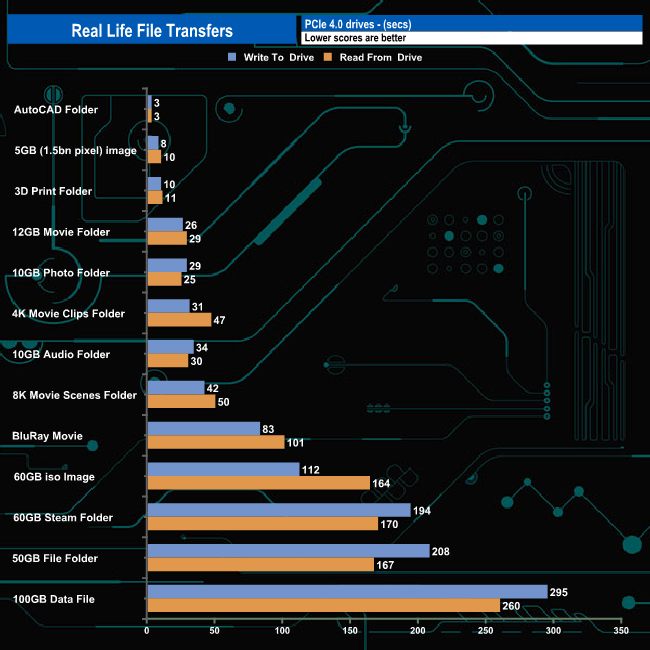
The drive was pretty consistent when dealing with the larger file transfers in our real-life file transfer tests averaging 539.83MB/s writing six of the largest folders to the drive and 428MB/s when reading them back. The fastest transfer was for the BluRay movie (549MB/s) with the slowest being, as usual, the 50GB file folder transfer at 247MB/s.
To get a measure of how much faster PCIe NVMe drives are than standard SATA SSD's we use the same files but transfer to and from a 2TB Kioxia Exceria Plus drive:
Swapping over to an all NVMe architecture saw transfer speeds rocket as you might expect. Three of the write transfers topped 3GB/s; 60GB iso 3,102MB/s, 100GB data file 3,102MB/s and the 5GB image, 3,092MB/s. Seven more topped 2.5GB/s while the slowest was the 50GB file folder with 955MB/s writing and 592MB/s reading.
WD's first PCIe Gen 4 drive, the very popular WD Black SN850, was and still is a very quick drive. But it was launched nearly two years ago, which in the Gen 4 drive market space, seems like an eternity. But now we have its successor for the fastest WD drive crown, the Black SN850X. WD are in the fortunate position to have all three parts of the component jigsaw; NAND, controller and cache chip available in-house so once again we have a WD controller, cache and 3D NAND. Instead of the BiCS4 96-layer that the Black SN850 used we have shiny new BiCS5 112-layer 3D TLC NAND in the Black SN850X.
At the time of writing this review, details on the SN850X's controller are pretty non-existent. If it is one of WD's in-house G2 controllers (that powers the SN850 as well as the SN770) it will probably have had updates made to the firmware to cater for the more advanced NAND in the SN850X. All we can say for certain is that the product codes on the controller for the SN850/SN770 are different to the SN850X; 20-82-10034-A1 and 20-82-20035-B2 respectively.
As with the Black SN850, the Black SN850X is available in three capacities, but it does way with the SN850's 500GB entry drive and instead has a 1TB entry drive along with 2TB and 4TB models. There are two versions of the drive, a plain one and a heatsink version, which is only available (at the time of writing) in the smallest two capacities. The heatsink version has RGB lighting but it is very subtle as the area for the lighting is only around 12mm x 3mm and only supports three of the thirteen lighting effects provided in the SSD Dashboard utility. Choosing the heatsink version over the vanilla drive will take around an extra tenner or so out of your budget.
WD quote Sequential read/write figures for the 2TB SN850X as up to 7,300MB/s and 6,600MB/s respectively which is a healthy 300MB/s and 1,500MB/s rise in read and writes respectively over the 2TB Black SN850. Incidentally, that 7,300MB/s read figure is the same for all three drives in the range. When it comes to Sequential writes the 4TB model gets the 6,600MB/s rating as does the 2TB drive with the 1TB drive rated as up to 6,300MB/s.
Using the ATTO benchmark we couldn't match those maximums, the tested drive producing a read figure of 6,820MB/s and a write figure of 6,230MB/s. However, switching over to the CrystalDiskMark 8 benchmark we could indeed confirm the official maximums with test results of 7,377MB/s (default-test) and 6,696MB/s (0 fill) for read and writes respectively.
As for random read performance, WD quote an up to 1,200,000 IOPS figure for the 2TB drive with random writes rated as up to 1,100,000 IOPS. Both are an improvement over the 2TB Black SN850 figures of 1,000,000 IOPS for reads and 710,000 IOPS for writes.
We couldn’t get close to these figures with our 4-threaded tests. The best read figure we saw was 446,377 IOPS. We then retested the drive at a QD of 32 and with 8 threads which resulted in a figure of 648,467 IOPS, closer to the official figure but no cigar. The fastest performance we saw from the drive came when using the Peak Performance profile (0 fill) in CrystalDiskMark 8 with a test result of 743,828 IOPS.
Random writes came up short in our tests as well. Our 4-threaded test yielded 362,876 IOPS at a queue depth of 32. Staying at the same queue depth but increasing the thread count to 8 saw the resulting figure rise to 464,466 IOPS. Again the fastest performance came via CrystalDiskMark 8's Peak Performance profile with a test result of 602,168 IOPS.
The drive is also supported by the very good WD SSD Dashboard management software. A pretty comprehensive utility, SSD dashboard allows you to monitor drive status, and performance, perform secure erases (currently only by making a bootable USB device), update firmware and monitor temperatures. The latest version of the utility includes the updated Gaming Mode 2.0. When turned on, the firmware disables the power-saving features that are incorporated into the drive allowing lower latencies and more performance. The one annoying aspect of this Gaming Mode is that you have to restart the system to enable/disable it.
The jury is out on the Game Mode 2.0, to be honest. When we tested the drive with 3D Mark's Storage Test we didn't see that much difference whether it was turned on or off. It's early days for the feature and hopefully, with time it should make more of an impact.
We found the 2TB version of WD's Black SN850X Heatsink on Overclockers UK for £329.99 (inc VAT) HERE.
Pros
- Stunning performance.
- Heatsink.
- WD Dashboard management utility.
- 5-year warranty.
Cons
- Couldn't hit the maximum 4K figures under testing.
- Pricey.
KitGuru says: WD's Black SN850 drive was already a very good flagship drive but with an upgrade from 96-layer to 112-layer NAND and improvements to the firmware, the SN850X takes over that mantle with great effect. But the price could do with some tweaking.
Be sure to check out our sponsors store EKWB here
 KitGuru KitGuru.net – Tech News | Hardware News | Hardware Reviews | IOS | Mobile | Gaming | Graphics Cards
KitGuru KitGuru.net – Tech News | Hardware News | Hardware Reviews | IOS | Mobile | Gaming | Graphics Cards


